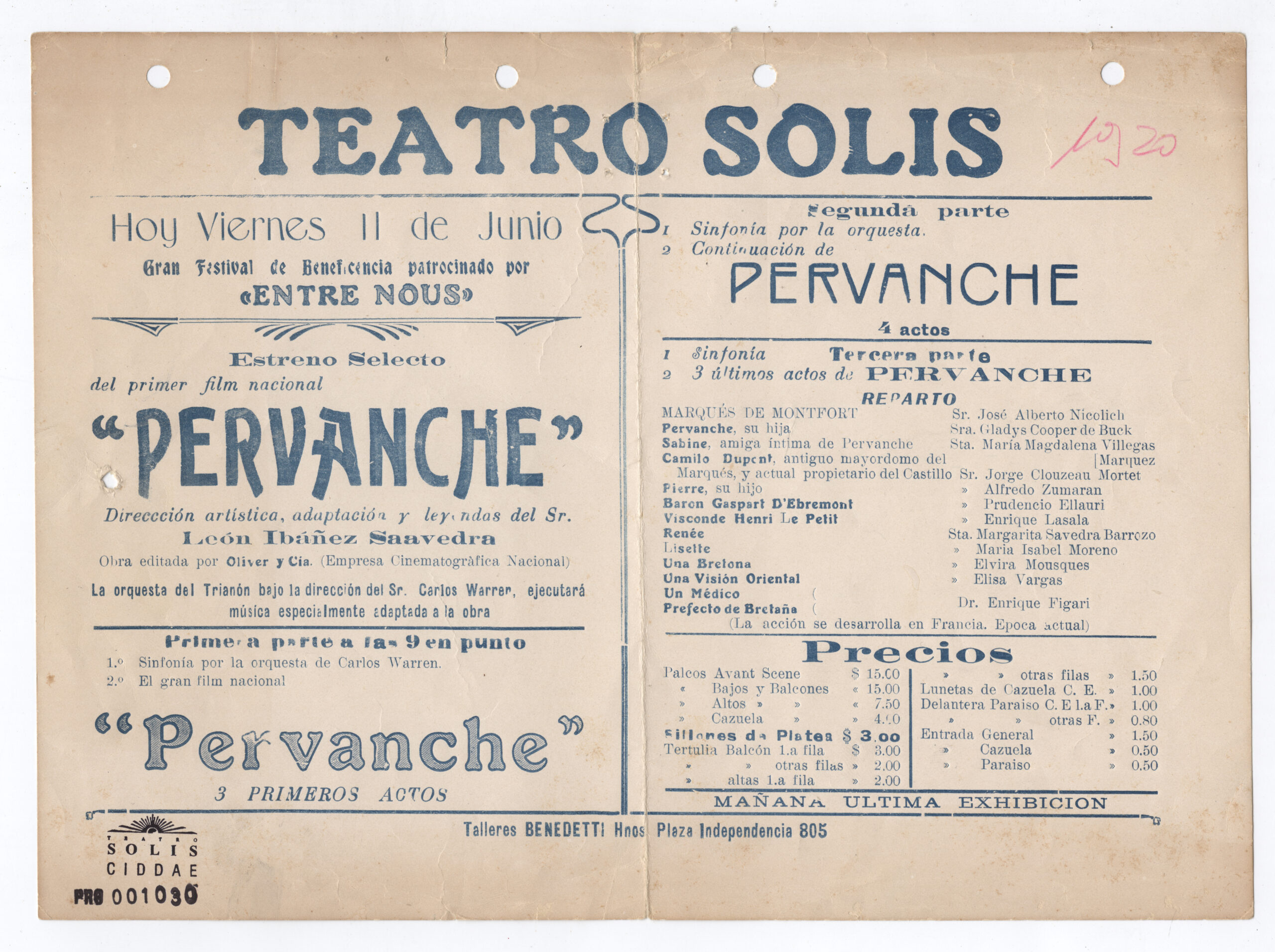Introduction
Women were involved in the cinematographic field in Uruguay since its beginnings and throughout the entire silent period. This early and sustained participation of women in the cultural sector is not surprising considering the consolidation of the modern Uruguayan State in the first decades of the twentieth century. Led from 1903 by progressive president José Batlle y Ordoñez, Uruguay was the terrain of innovative reforms at the continental level, both during Batlle’s two presidencies (1903-1907 and 1911-1915) and, subsequently, until his death in 1929 through his political affiliates, the Batllista sector of the Colorado Party. Within a broad framework of economic, fiscal, rural, and social reforms—among them, the eight-hour work day, the secularization of education, and the ability for women to file for divorce—the female population was able to carve out spaces of relative autonomy. Women participated in the debates about their position in society, fighting for their own rights and for the rights and well-being of those in need, thus taking part in direct social actions.1On the relations between women, politics, and the state in Uruguay see Silvia Rodríguez Villamil and Graciela Sapriza, Mujer, Estado y política en el Uruguay del siglo XX (Montevideo: Ediciones de la Banda Oriental, 1984); Asunción Lavrin, Women, Feminism, and Social Change in Argentina, Chile, and Uruguay, 1890-1940 (Lincoln: University of Nebraska Press, 1995); Christine Ehrick, The Shield of the Weak: Feminism and the State in Uruguay, 1903-1933 (Albuquerque: University of New Mexico Press, 2005); Inés Cuadro Cawen, Feminismos y política en el Uruguay del novecientos. Internacionalismo, culturas políticas e identidades de género (1906-1932) (Montevideo: Ediciones de la Banda Oriental, 2018). On political anti-feminism tendencies and discourses in Uruguay, see Inés Cuadro Cawen, “Antifeminismos en el Uruguay en las primeras décadas del siglo XX.” In Historia de los conservadores y de las derechas en Uruguay. De la contrarrevolución a la Segunda Guerra Mundial, eds., Magdalena Broquetas and Gerardo Caetano (Montevideo: Banda Oriental, 2022), 176-191. Their many political and social crusades not only gave women more freedoms, but also a new visibility in the rapidly modernizing society. One group of women that was particularly outspoken and visible during this time was also especially active in cinema: the elite. Upper-class society ladies quickly understood the many possibilities of the medium and, unlike other groups of women (the working class, middle-class wives, or even feminists), they had the social and economic power to engage with this new field. Thus, while female participation in the cinema transcended class, as this essay reveals, the elite’s powerful position in society, with direct access to the press and time for creative endeavors, determined the group’s (omni)presence.
This overview essay deals with the various modalities of female participation within the Uruguayan cinematographic arena, from an early example in 1900, through the 1910s when the field began to consolidate, and until the end of the silent period in the late 1920s.2Although imported sound films arrived in Uruguay in 1929, the last national silent production—El pequeño héroe del Arroyo del Oro—dates from 1932. As in many countries, silent and sound films coexisted in Uruguay until the mid-1930s. It seeks to not only insert these modalities of interaction into the historiography of a national cinema, but also to “rescue” women’s names and images, removing them from the anonymity in which they were plunged by the passage of time and a century-long lack of interest from chroniclers and researchers. Given the absence of specialized archives on the subject, both names and practices can only be (re)constructed from fragments: news items in the daily press, specialized magazines, occasional publications, and ephemera. This new information forces us, as feminist film historians, to not only rethink the cinematographic field of that time, but also to reconsider our own research in fundamentally more fragmented terms as well as to reassess the ways in which our work develops, including the gaps it fills and the absences that remain. In short, this reconstruction process necessitates the reorganization of feminine action in the past and ours in the present.
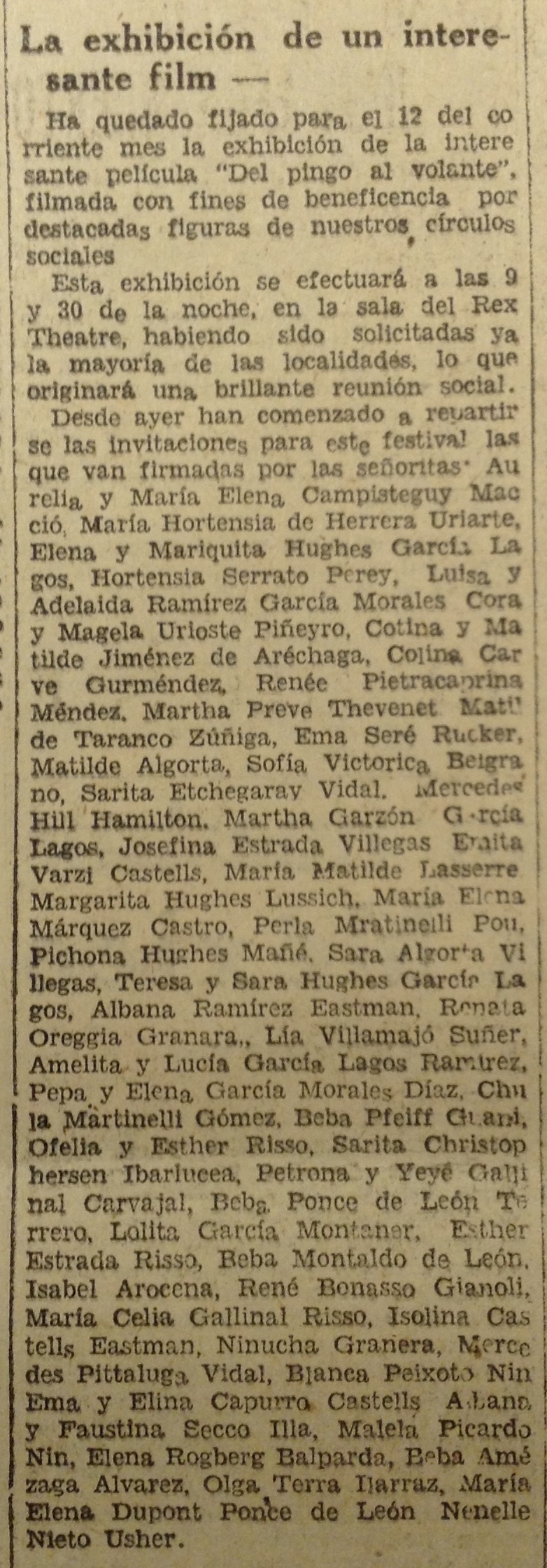
Advertisement for the premiere of Del pingo al volante (1929) that “name drops” all the upper-class women involved. El País (4 August 1929).
The title of this essay is a play on the expression of “name dropping.” Taken seriously, it refers to the social prestige that several of the upper-class women discussed below had in Uruguayan society at the time as well as to the reputation and authority that these names hypothetically transferred onto whomever was quoting them. In addition, the phrase brings into play the practice of listing (their own) names (or, again, the practice of “name dropping”) that some groups of women did for themselves, as I will show, when promoting film events they organized. Conversely, it tacitly comments on how no such prestige was associated at that time with quoting, for instance, the names of middle-class musicians who performed in movie theaters. Finally, the title of this essay is an ironic comment on all these women’s total erasure in the present; it is a reflection upon the often frustrating scholarly work of reinstating “dropped” names that are unknown today or perceived as irrelevant to film history. To this end, this essay claims that despite any strategic “uselessness” of compiling names, it is urgent work in order to fully understand the Uruguayan cinematographic field and to integrate these women into the seemingly “neutral”—but exclusively male—list of names that has for decades shaped silent film history in Uruguay.
Thus, in this essay, I both quote these original lists and create new ones at the end of each section: lists of names that, in most cases, are all that remain from these film-related activities. Since there are practically no printed interviews or statements from the women involved in Uruguayan silent cinema, it is not possible to hear their voices, not even mediated by journalists or editorials. For this reason, I am unable to interpret their ideas and (dis)comforts. There are no declarations, just names and facts—actually, chronicles of the facts. However, using these names and facts, I will map out and reflect upon women’s involvement in the cinematographic field. The danger is, at times, to slide into stark inventories. Yet, I believe it is a necessary risk and, hopefully, will inspire continued research.
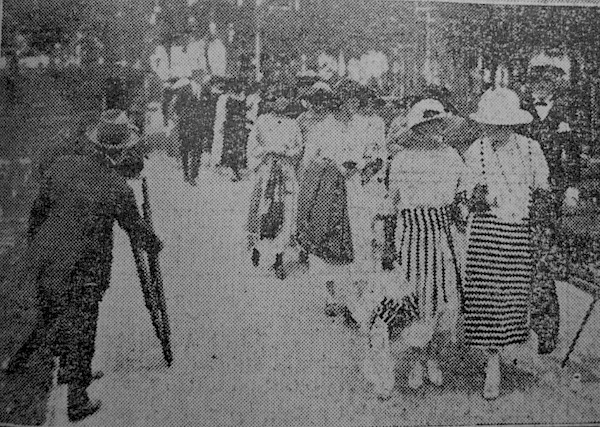
A charity film being shot in the Prado neighborhood in Montevideo. “Fridays at the Cine Doré.” La Mañana (19 March 1922).
One of the goals of this essay is to shed light on the importance of women in the creation of the first film productions in Uruguay, an activity that was mainly carried out by high-society women—those who obviously had the means and connections to sustain such endeavors. As the essay unfolds, it will become clear that the engine behind many (relative) accomplishments and enterprises in primordial Uruguayan cinema were upper-class female charitable associations, whose members were eager to explore cinema’s possibilities as part of their social and civic agendas.3The participation of the female elite in the cinematographic field seems to have been a constant in Latin America, although there are still few specific studies on the subject. The most consistent example is: Lucio Mafud, Entre preceptos y derechos. Directoras y guionistas en el cine mudo argentino (1915-1933) (Mar del Plata: Festival de Mar del Plata, 2021), and by the same author, “Mujeres cineastas en el periodo mudo argentino: los films de las sociedades de beneficencia (1915-1919).” Imagofagia no. 16 (October 2017): 51-76. On a smaller scale, women of other social strata played a part in this emerging field, and this essay constitutes a first survey of other key figures. As cinema as a social phenomenon grew stronger, middle-class women were attracted to its potential as both an object of intellectual reflection and as a possibility for work and emancipation. This is true, to varying degrees, for women writers and intellectuals and for female musicians who accompanied films in theaters.
The first section of this essay situates my research in relation to several key feminist film historiographical interventions in recent decades. Responding to the calls for wider fields of inquiry, I embrace the need to look at practices where female action was relevant but was not sufficiently considered. As I will show, this is particularly important when rethinking Uruguayan film historiography more broadly. Thus, connecting two projects—the feminist agenda and a specific national historiography—allows me to (re)construct a field that, until today, was inevitably disjointed. I also include here a brief survey of “professional” actresses, who, due to my larger focus, I will not consider in the rest of the essay.
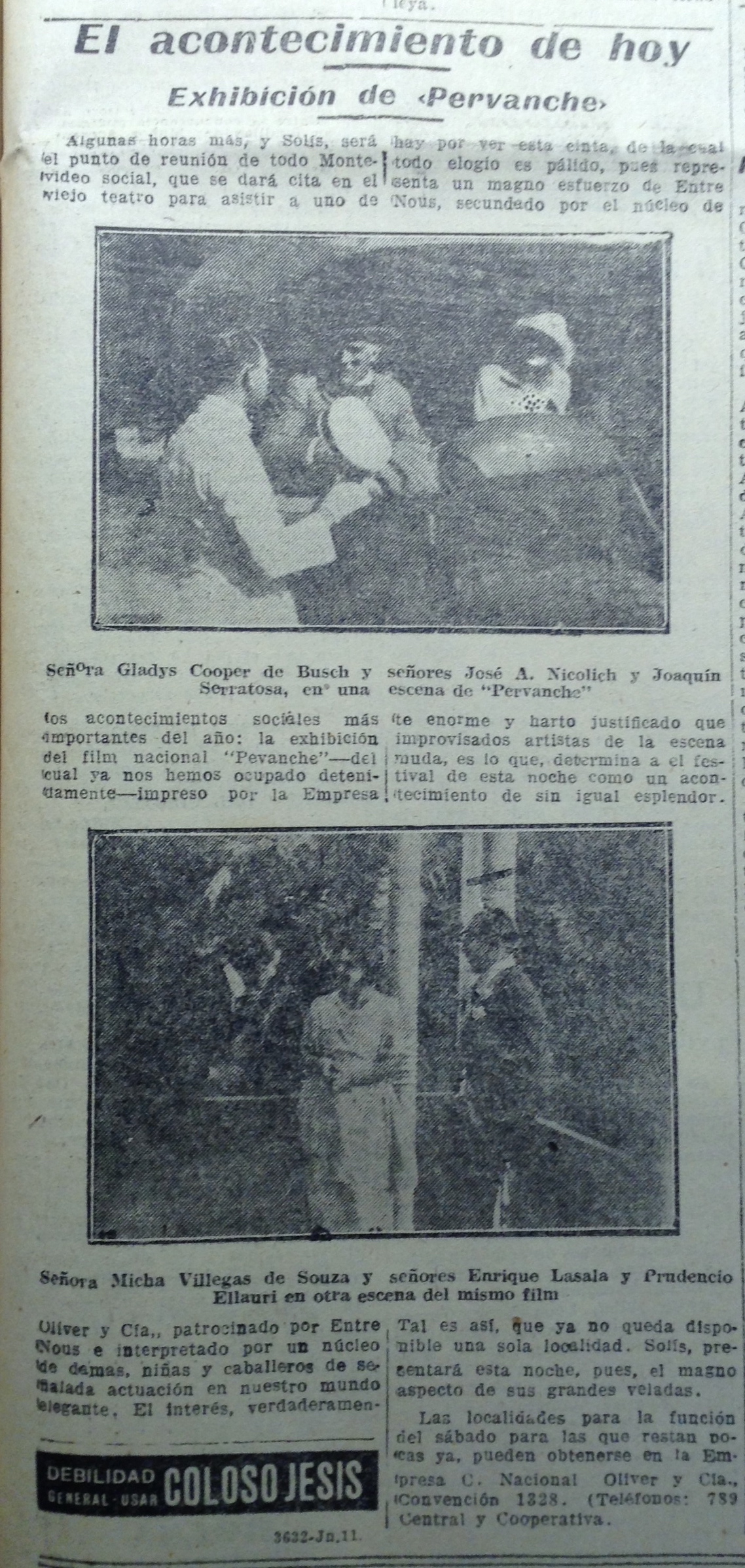
Newspaper announcement for the premiere of Pervanche (1920). “El acontecimiento de hoy.” La Razón (11 June 1920).
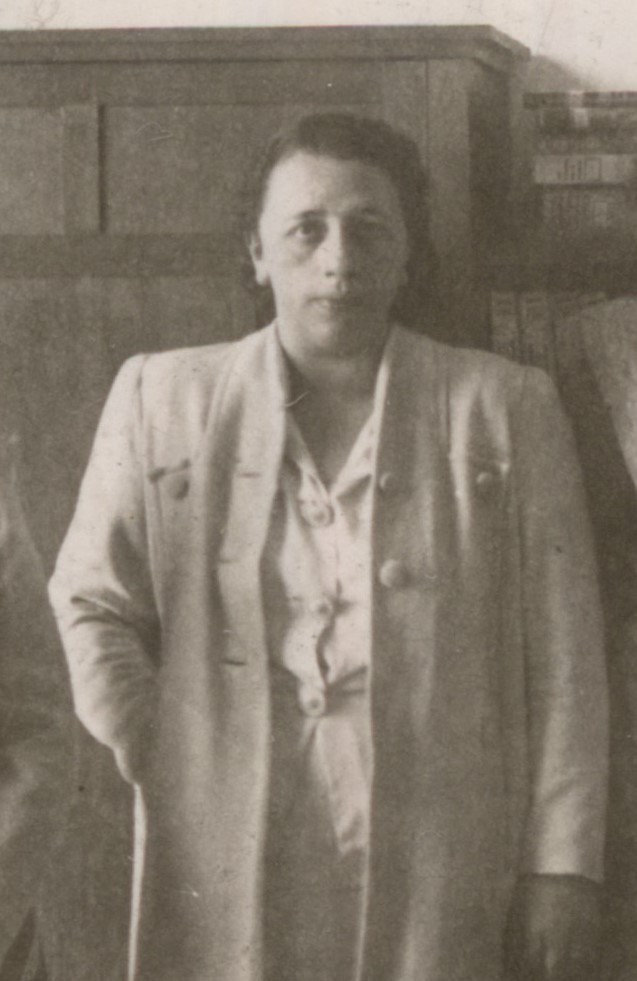
Musician Sisa Bonino. Private Collection.
The sections that follow are organized chronologically. The second section examines the early participation of women in film exhibition, especially the presentation practice of combining still and moving images that started in 1900 and spanned through the 1920s. In fact, for many decades, both fixed projection (which often allowed women to integrate Uruguayan themes into the program) and moving images (generally, foreign films) animated Uruguayan society soirées. The third section considers a fiction film project, Artigas (1915), which was conceived by a female charitable association but was never completed. The fourth section focuses on the first feature film, Pervanche (1920), made possible by another female charitable association. It is followed by a discussion of key women intellectuals and writers and their public engagement with the new medium. The sixth section is dedicated to the last silent film produced by a female charitable association, Del pingo al volante (1929). Finally, the last section of this essay before the conclusion moves toward the middle-class, also the largest group of film consumers, to explore women’s relation to cinema as a workplace, focusing on the role of female musicians during film exhibitions. Though information is scarce—we have just a few names of women who performed in movie theaters in the 1920s—the fragments we do have underscore the link between cinema, women, and work. This final section allows me to “give back names” to those women who entertained Uruguayan moviegoers.
“Diverse Figures”
Although much work has been done by Uruguayan feminists at diverse levels, the relation between women and cinema was only recently taken into account.4For initiatives and discussions in other periods, see, among others, Soledad Castro Lazaroff, “Las historias ausentes.” La diaria (7 May 2018). https://ladiaria.com.uy/feminismos/articulo/2018/5/las-historias-ausentes/; Álvaro Lema Mosca,“Historia del cine en uruguay: mujeres y cine.” Revista Film (2020). https://www.revistafilm.com/historia-del-cine-en-uruguay/; Marta García, Isabel García, Noelia Torres, Agostina Dati, Rocío Llambí, Raquel Sabrido, Rocío López, and Alicia Cano, ¿Quiénes cuentan las historias? El cine uruguayo desde una perspectiva de género 2008-2018 (Montevideo: MAU, 2020); Jorge Fierro, “Nietas de las pioneras.” Brecha (February 2021). https://brecha.com.uy/nietas-de-las-pioneras/. For women in silent cinema, the situation is even less articulated. Indeed, histories of Uruguayan cinema devote little space to the silent era and references to women are reduced to only a few names of actresses. Thus, I operate at a sort of degree zero. Yet, it is a degree zero that has the advantage of looking at positions and discussions in feminist scholarship from a distance, and putting them to the test in this national context with its specific conditions of existence and production.5Outside of Uruguay, in the last two decades, there have been important theoretical and historiographic developments, in addition to the investigation of specific cases, that not only questioned the ways historical narratives are constructed, but that also incorporated female work in different areas of the global cinematographic field. Here, I only list a selection of key texts with which this essay, in some way, is in conversation: Shelley Stamp, Movie-Struck Girls Women and Motion Picture Culture After the Nickelodeon (Princeton: Princeton University Press, 2000); Jennifer M. Bean and Diane Negra, eds., A Feminist Reader in Early Cinema (Durham: Duke University Press, 2002); Rosanna Maule and Catherine Russell, eds., “Cinephilia and Women’s Cinema.” Framework no. 1 (2005); Monica Dall’Asta, ed., Non solo dive. Pioniere del Cinema italiano (Bologna: Cineteca di Bologna, 2008); Christine Gledhill and Julia Knight, eds., Doing Women’s Film History: Reframing Cinemas, Past and Future (Urbana: University of Illinois Press, 2015); Jane M. Gaines, Pink-Slipped: What Happened to Women in the Silent Film Industries? (Urbana: University of Illinois Press, 2018). In fact, in Uruguay, as in most Latin American countries, early film production was artisanal and episodic, and the country never succeeded in building a real film industry.6See Ana M. López, “Early Cinema and Modernity in Latin America.” Cinema Journal vol. 40, no. 1 (Autumn 2000): 48-78; Paulo Antonio Paranaguá, Tradición y modernidad en el cine de América Latina (Madrid: Fondo de Cultura Económica de España, 2003). In this context, it is thus necessary to specify the terms of the aforementioned alliance between women and cinema because it is an alliance only thinkable if we consider how current research on cinema and women has questioned central categories in order to explore “diverse figures.”7Christine Gledhill, “Pensare le donne nella storia del cinema.” In Non solo dive. Pioniere del Cinema italiano, ed. Monica Dall’Asta (Bologna: Cineteca di Bologna, 2008), 31. On the one hand, recent feminist film scholarship has incorporated into its scope marginal presences beyond the more traditional and widely studied professional categories of female directors or actresses. On the other hand, it has started considering women with no direct feminist or progressive agendas, integrating different strata of society and political positions into the conversation. Both “turns” are key to my work.
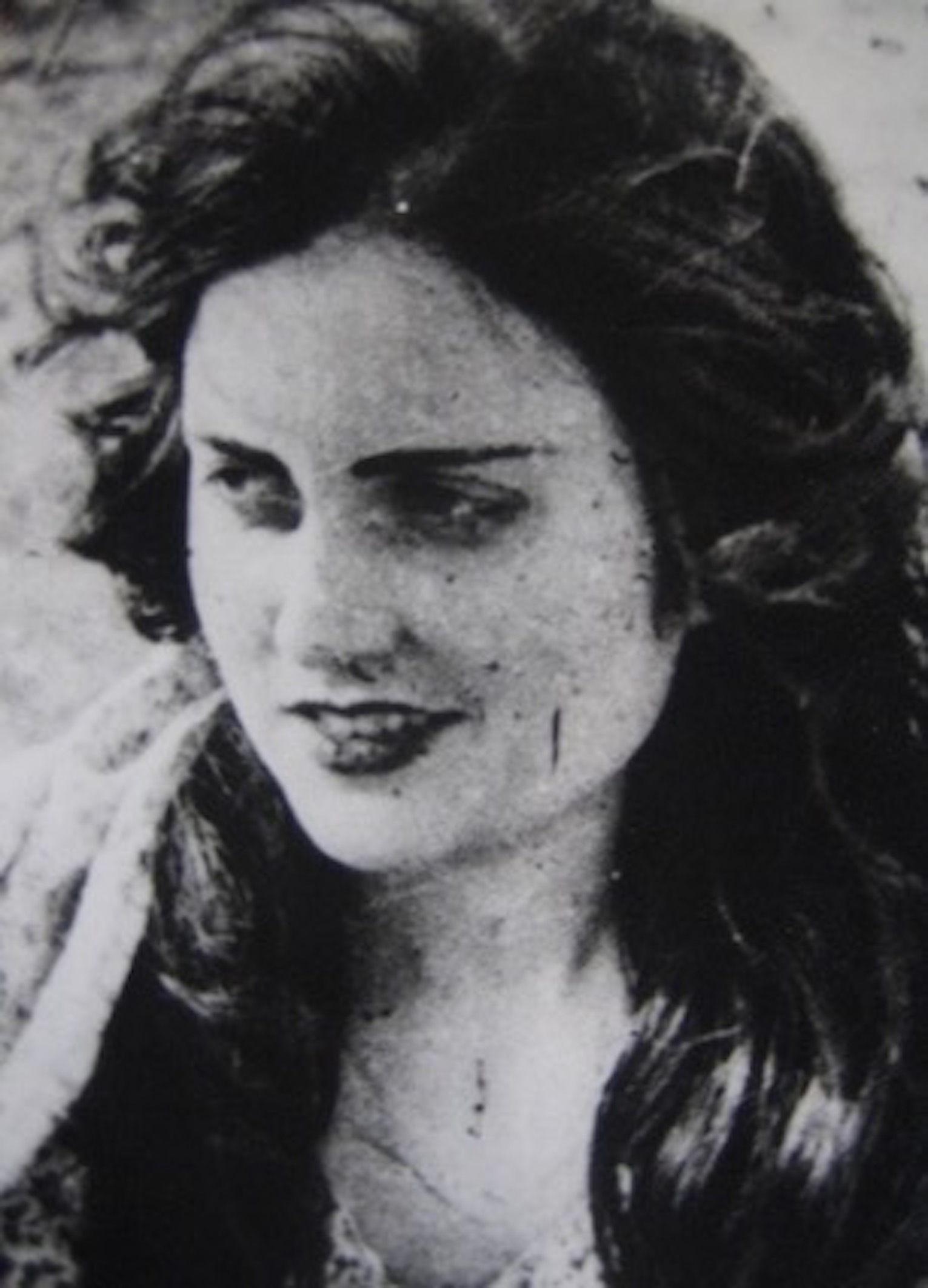
Luisa T. de Cavalieri. Courtesy of the CDC-Cinemateca Uruguaya.
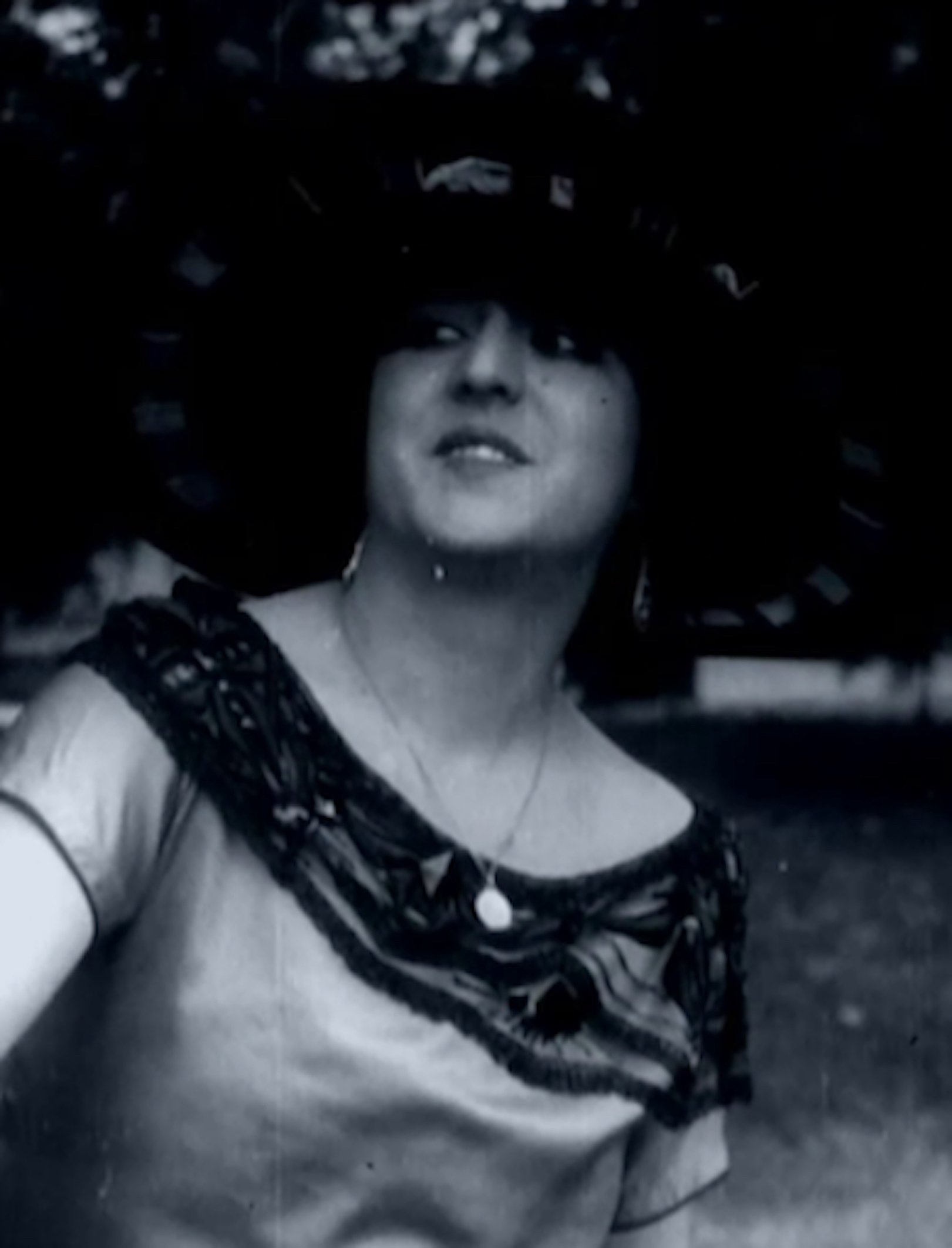
Frame enlargement, Judith Acosta y Lara in Almas de la costa (1923). Courtesy of the Cinemateca Uruguaya.
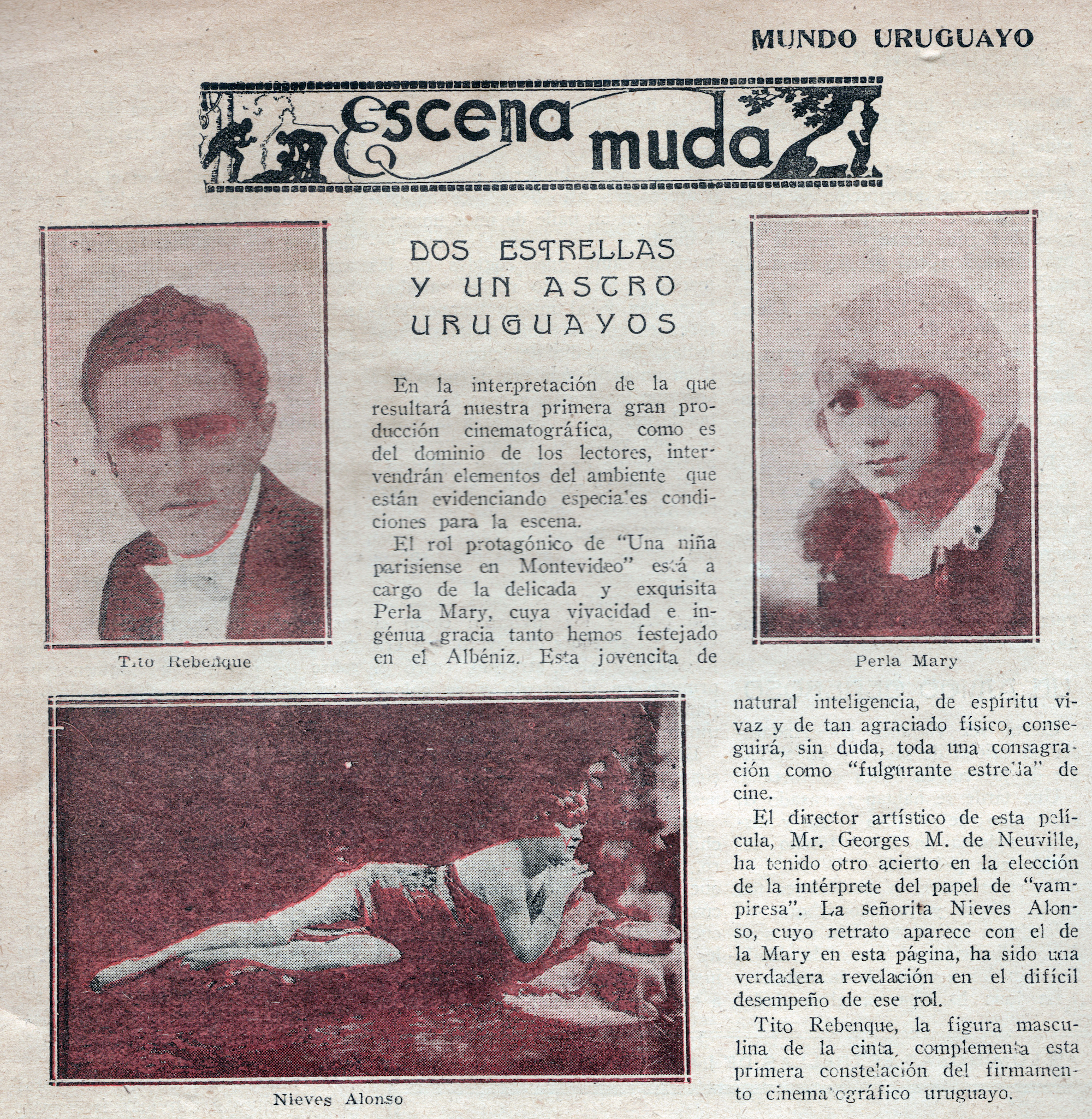
Perla Mary and Nieves Alonso, “Dos estrellas y un astro uruguayos.” Mundo uruguayo VI, no. 297 (18 September 1924).
In the first instance, if we did not widen our scope, we must wait until 1938 for the first female director, namely Rina Massardi, who produced, directed, and starred in her only film, the musical Vocation.8Inés Olmedo, Rina, la primera. Catálogo de la muestra (Montevideo: FCC/MEC, ICAU, 2014). Moreover, the majority of women involved in Uruguayan silent cinema, as I mentioned before, were elite amateurs that approached movies with no training in the field or with the intention of becoming professionals. Indeed, if we are to be guided only by such a historically charged category like professional, we must wait until the middle of the 1920s for the first “professional” Uruguayan actresses. These women appeared in the first “commercial” fiction films—that is, films conceived outside the charity sphere but equally not industrial in nature—which were small one-off productions made by local entrepreneurs and that followed the narrative prerogatives of foreign cinema at the time, centering their plots around female protagonists. The first of these one-time actresses was Luisa T. de Cavalieri, who played a girl suffering from tuberculosis in Almas de la Costa/Souls of the Coast (1924), directed by Juan A. Borges. She competed for the male protagonist with a character played by Judith Acosta y Lara, a “flirtatious, frivolous and seductive” femme fatale, according to the press.9“Almas de la Costa. Judith Anna Betty, una estrella de especiales merecimientos artísticos.” El Plata (24 September 1924): 6. The rest of the female cast included Mrs. De Lara and Ida Gracia Livio. The same year, the Uruguayan public was able to admire Perla Mary for the first time, the only one of these actresses who would later have a film career (in Argentina).10The same happened with the Uruguayan Orfilia Rico, protagonist of the Argentine films Nobleza Gaucha/Gaucho Nobility (1915?), directed by Humberto Cairo; Hasta después de muerta/Until After Death (1916), directed by Florencio Parravicini; and Viruta y Chicharrón/Viruta and Chicharrón (1915 -1916?), presumably directed by Héctor G. Quiroga and José González Castillo. See Lucio Mafud, La imagen ausente. El cine mudo argentino en publicaciones gráficas. Catálogo. El cine de ficción 1914-1923 (Buenos Aires: Teseo, 2016), 67, 105, 134. She also appeared in Cine-Mundial, the Spanish version of The Moving Picture World. See “Favoritos del cine.” Cine-Mundial (October 1917): 500. She starred as a “rich and capricious girl” in the presumed lost Una niña parisiense en Montevideo/A Parisian Girl in Montevideo (1924), directed by Frenchman Jorge M. De Neuville.11The rest of the female cast included Nenucha Puig Chucarro, Pina García, Rosario Millán, and the participation of “450 girls,” as stated in the film program. The film also included a femme fatale character played by Nieves Alonso. Finally, it is also worth mentioning El pequeño héroe del Arroyo del Oro/The Little Hero of the Golden Stream (1932), by Carlos Alonso, the last and most popular film of the silent period. Although the female characters are secondary in the story, based on a real-life murder from 1929, I will still “drop” their names here: Celina Sánchez and Hilda Quinteros.
Thus, if women acted very little professionally and did not direct at all during the silent era in Uruguay, the concept of “diverse figures” productively reorients attention to other activities, such as acting in and producing amateur productions, organizing film programs in local cinemas, outlining screenplays, writing about film in literature and the press, playing music in movie theaters, and producing actualities that captured elite social activities that would be screened at charity events. It also allows for an appreciation of the non-professional work of charitable associations. As noted in the Introduction, the most solid and organized form of female cinematic participation—and the one on which I will mainly focus—was through charitable associations that identified the new medium as an effective tool for raising funds and promoting their causes. Charities actually influenced the entire Uruguayan cinematic domain through the screenings of imported movies, as well as through the production of short documentaries and fiction films. In fact, two of the five fiction films produced in the country during the silent period were the result of women’s initiatives of this kind.
The second aforementioned feminist film historiographical “turn,” toward “diverse figures” occupying various ideological positions, enables me to give space to women not directly involved with feminist or progressive agendas. This entails both elite women working in charitable associations, many of whom were married to upper-class intellectuals, politicians, landowners, and descendants of patrician families, and middle or even working-class women without any known political affiliation. Concentrating on these “diverse figures” allows us to focus on their actions vis-à-vis the cinematographic field and what they generated in symbolic terms. In the case of the former, for example, we are able to identify how their elite status largely determined how films were produced, what their literary and aesthetic models were, what parts of the city were shown onscreen, which topics they addressed and, finally, the very representation of their gender. For instance, it is clear that their privileged position and group synergy permitted these elite women to establish alliances with producers in order to construct their own narratives, with theater owners to negotiate deals with central and prestigious venues, and with the press to spread the word about their activities. Although, of course, women’s power was still feeble compared to men’s influence, as already noted, from the turn of the twentieth century it had increased and, in the 1920s, it grew stronger as female presence in the public sphere augmented notably in the country.12See Gabriela Sapriza, “La Nueva Mujer en las carátulas de Mundo Uruguayo.” In Los veinte: el proyecto uruguayo; arte y diseño de un imaginario 1916-1934, ed. Gabriel Peluffo Linari (Montevideo: Museo Municipal de Bellas Artes Juan Manuel Blanes, 1999): 123-126. It is evident thus that elite women acted in and influenced the cultural milieu of their time. Rescuing their names, along with those of other Uruguayan middle-class intellectuals and musicians, has to do with the need to inquire about their concrete practices and to have a more complete panorama of Uruguayan silent cinema.
Although the connections between Uruguayan silent cinema and charitable work has not been completely ignored, early historians did not delve into it.13See José Carlos Álvarez, Breve historia del cine uruguayo (Montevideo: Cinemateca Uruguaya, 1957); Eugenio Hintz, ed., Historia y filmografía del cine uruguayo (Montevideo: Ediciones de la Plaza, 1988); Manuel Martínez Carril and Guillermo Zapiola, La historia no oficial del cine uruguayo (1898-2002) (Montevideo: Ediciones Banda Oriental, 2002); Jorge Ruffinelli, Para verte mejor. El nuevo cine uruguayo y todo lo anterior (Montevideo: Trilce, 2015). It was Christine Ehrick who, in her pioneering 2006 article “Beneficent Cinema: State Formation, Elite Reproduction, and Silent Film in Uruguay, 1910s-1920s,” effectively explored for the first time women’s key role, accounting for charities’ feminine origins and analyzing Del pingo al volante, the only charitable film that survives.14Christine Ehrick, “Beneficent Cinema: State Formation, Elite Reproduction, and Silent Film in Uruguay, 1910s-1920s.” The Americas vol. 63, no. 2 (October 2006): 205-224. Her article states that three fiction films were produced by these associations. However, only Pervanche (1920) and Del pingo al volante (1929) were products of charity associations. The third one mentioned by Ehrick, Adventures of a Parisian Girl in Montevideo (whose correct title is A Parisian Girl in Montevideo) was not a charity production, and it was released in 1924 and not in 1927 as stated in the article. These inaccuracies do not diminish the importance of an article that analyzes, in a very articulated way, several of the dynamics involved in these charitable productions and, in particular, the narrative construction of Del pingo al volante. Interested in the power dynamics existing between these associations and the Uruguayan State, Ehrick correctly highlighted to what extent the “beneficent cinema speaks to the ways in which film, as a visual medium, played to elite audiences’ narcissistic and nationalistic desires to see themselves (literally and symbolically) projected on the big screen.”15Ehrick, “Beneficent Cinema,” 206. In addition, she foregrounded how charities also used cinema to promote their pedagogic, aesthetic, and social agendas. What follows, thanks to extensive research in the Uruguayan press and in film archives, builds upon Ehrick’s hypothesis with a corpus of data and footage not previously available, furthering the importance of elite women’s complex participation in early Uruguayan cinema. Yet while Ehrick was focused on charity and cinema, I am interested here in cinema and women more broadly. This wider focus allows me to also look beyond the upper class and present some new names of women who, despite being less prominent, also helped to shape the cinematic field at the time.
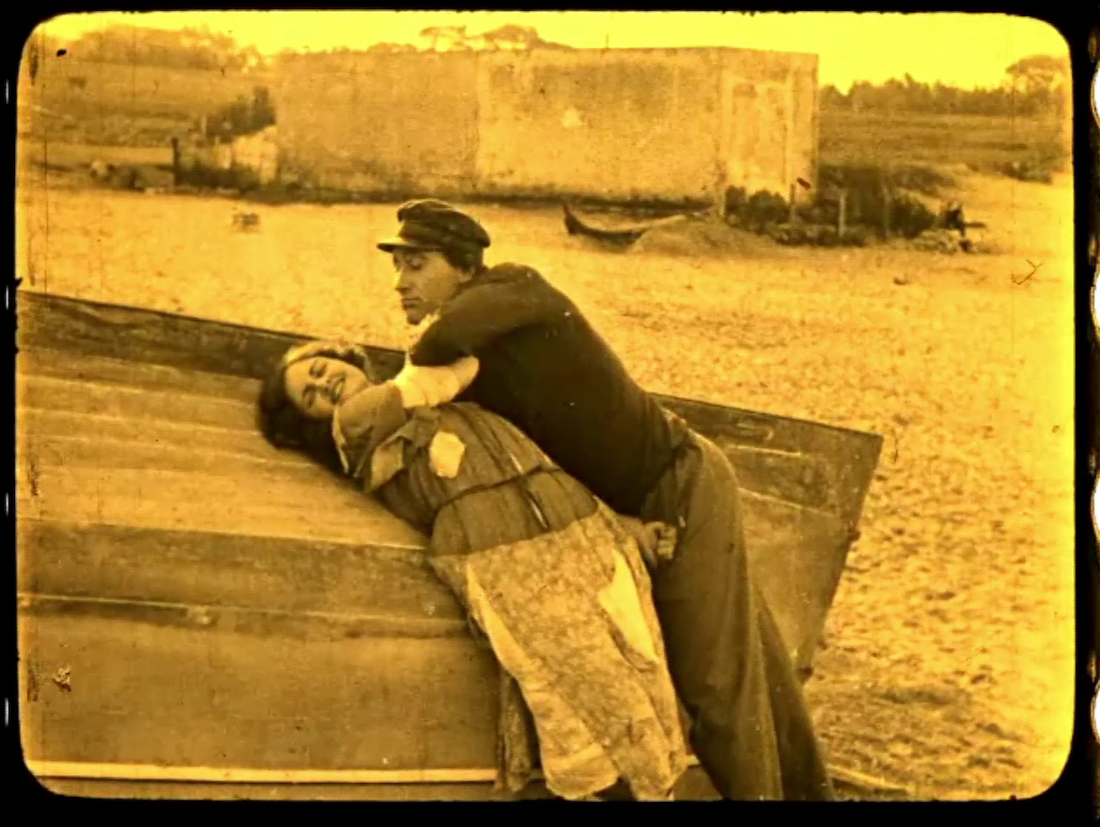
Frame enlargement, Almas de la costa. Courtesy of the Cinemateca Uruguaya.
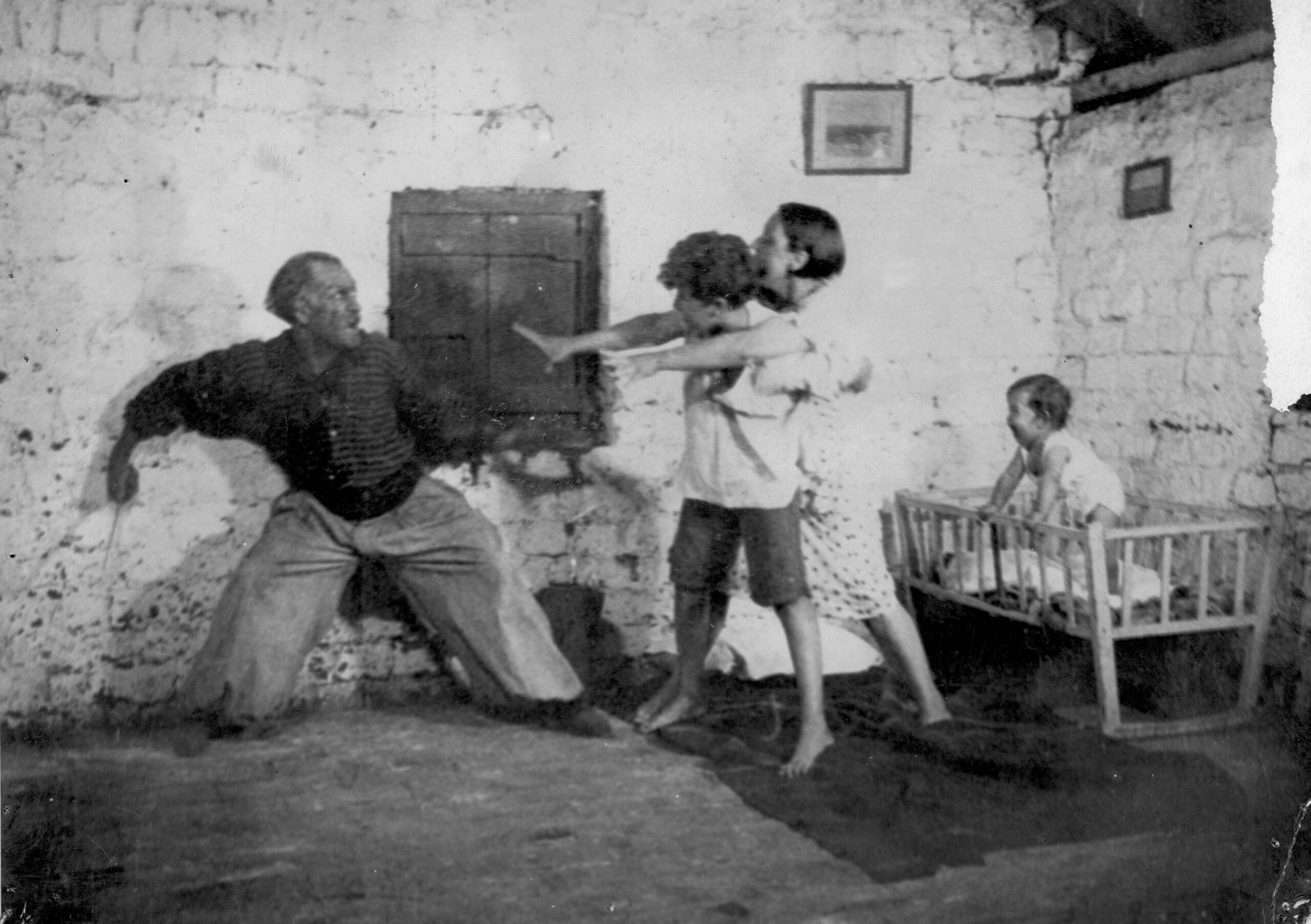
Film still, El pequeño héroe del Arroyo del Oro (1932). Celina Sánchez (mother of Dionisio) and Hilda Quinteros (baby sister). Courtesy of the Cinemateca Uruguaya.
The First Professional Film Actresses in Uruguay: Luisa T. de Cavalieri, Judith Acosta y Lara, Mrs. De Lara, Ida Gracia Livio, Perla Mary, Nieves Alonso, Nenucha Puig Chucarro, Pina García, Rosario Millán, Celina Sánchez, Hilda Quinteros.
Film Exhibition: Between Stillness and Motion
The connection between charity and entertainment can be found in Uruguay as early as the middle of the nineteenth century, during the Guerra Grande [Civil War] (1839–1851). Before the century came to a close, charitable associations often held bazaars, recitals, dances, live paintings, and other public performances to raise money for their projects. Therefore, it is not surprising that they quickly embraced the new medium of cinema in a similar capacity.16See: José Salgado, “Las damas orientales en la Beneficencia Pública.” Revista Nacional. Literatura, arte, ciencia no. 49 (January 1942): 30-42; Mariano Ferreira, “La mujer Uruguaya en la Beneficencia pública.” Revista del Instituto Histórico y Geográfico del Uruguay (1920): 99-116. One of the earliest examples dates from 1900. It was a “perfected magic lantern” show directed by an “intelligent and distinguished young lady of our society” to raise money for an unnamed charity and took place in the provinces.17“Linterna Mágica.” La Campaña (11 July 1900): 2. It is difficult to be certain whether this was literally a magic lantern show or a cinematic projection since, for a considerable period of time, the term “magic lantern” was used for both.18See André Gaudreault and Philippe Marion,“A Medium is Always Born Twice.” Early Popular Visual Culture vol. 3, no. 1 (May 2005): 3-15; Giusy Pisano, “Les spectacles mixtes. Tradition ou anachronisme? Survivances sonores et visuelles de Robertson à Georges Lordier.” In Le muet a la parole. Cinéma et performances à l’aube du XXe. Siècle, eds. Giusy Pisano and Valérie Pozner (Paris: AFRHC, 2005): 101-134. On this practice in Uruguay, see Georgina Torello, La conquista del espacio. Cine silente uruguayo (1915-1932) (Montevideo: Yaugurú, 2018): 77-110. This anonymous young woman could also have been performing an early version of the type of spectacle that, in the following decades, would become customary for elite entertainment, namely the screening of a combination of fixed and moving images at charity events. Regardless, she was taking part in early film presentation practices. If much research on the subject still needs to be done, it is safe to assume, looking at the presence in the press of women organizing similar exhibitions during the following decades, that the legitimating process from 1900 onward was rather quick. In fact, by the 1910s, anonymity was abandoned and women’s names appeared often in connection to similar events; as I will show, the names of the organizers would specifically become a big part of the promotion of the event in the newspapers.
As noted above, during the 1910s, one of the practices adopted by charity groups was the inclusion of photo projections in their film exhibitions. The concomitance of still and moving images was a very common practice, globally, in the first decade of the twentieth century, but it progressively fell into disuse as cinema acquired autonomy. In Uruguay, however, this practice was prolonged, in charity film exhibition, until the end of the 1920s. In these decades, charity shows often mingled the latest foreign feature films and self-produced actualities with projections of photographic series. These fixed presentations offered portraits of the ladies and children (sometimes also the gentlemen) of the ruling class—both in serious and comic fashion—and shots of social events, mostly charity parties, walks on the beach, outings to the racetrack, dances in sumptuous hotels, and weddings.
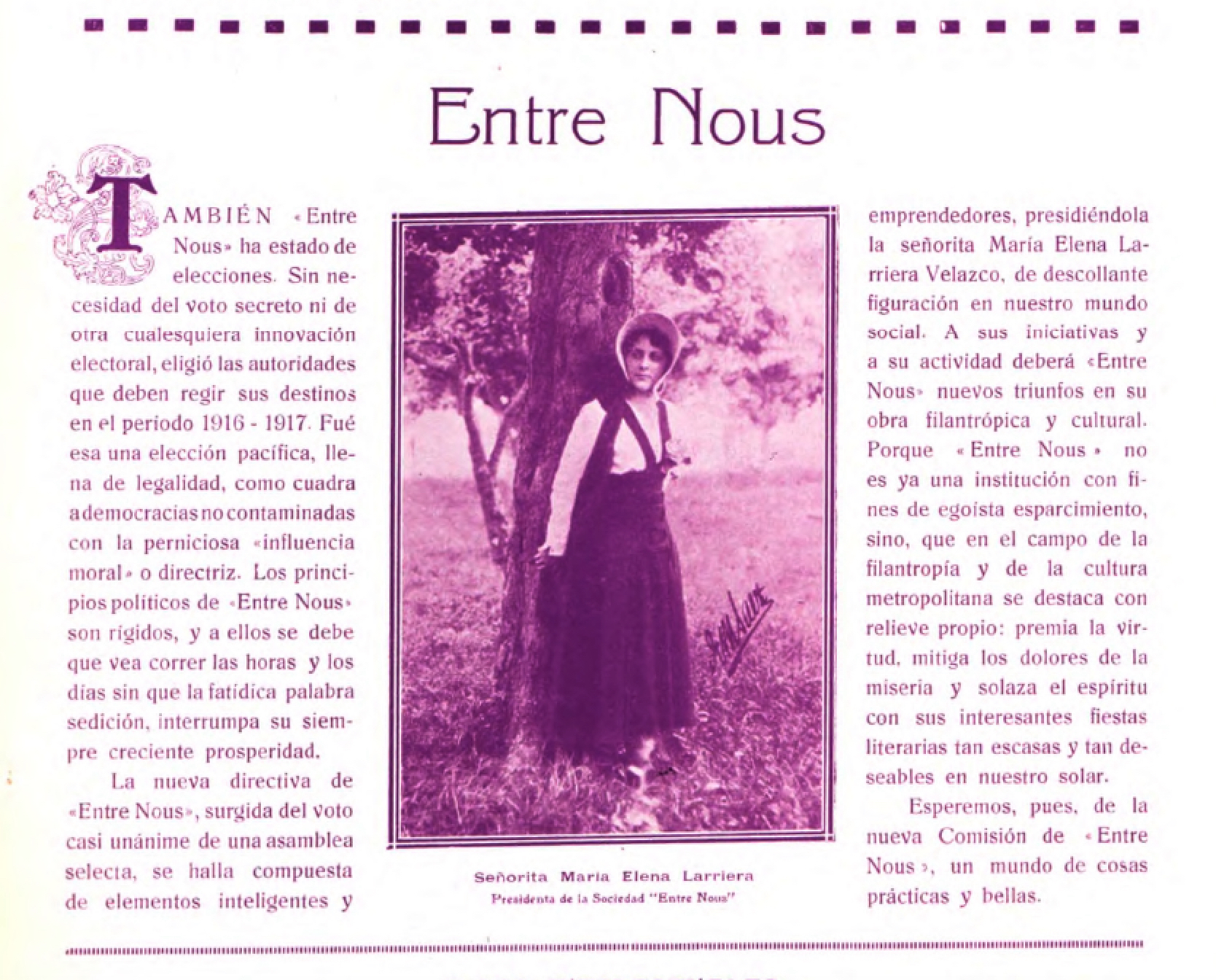
María Elena Larriera, c. 1916, in Anales. Revista nacional, no. 11.
For example, in 1917, María Elena Larriera, the president of Entre Nous, an association of upper-class women who sewed items for the lower classes and organized different events to finance their activities,19“Entre Nous.” La Razón (19 June 1917): 4. arranged a screening at the Buckingham Salón, one of the most prestigious venues in the capital. In addition to listing the names of the women involved in the event, the program, printed in the press, informed the public that feature films would be screened. But whereas no film titles were given, a detailed list of the photographs of social events sponsored by Entre Nous, which would be projected on the screen during the event, appeared. This list included the description of group portraits of the members of Entre Nous and its general assembly, choir rehearsals, prize distributions, horse races, sewing workshops, excursions, and other gatherings. Hence, a picture of high society of the time was drawn: visually, on the screen, and discursively, on the newspaper page.
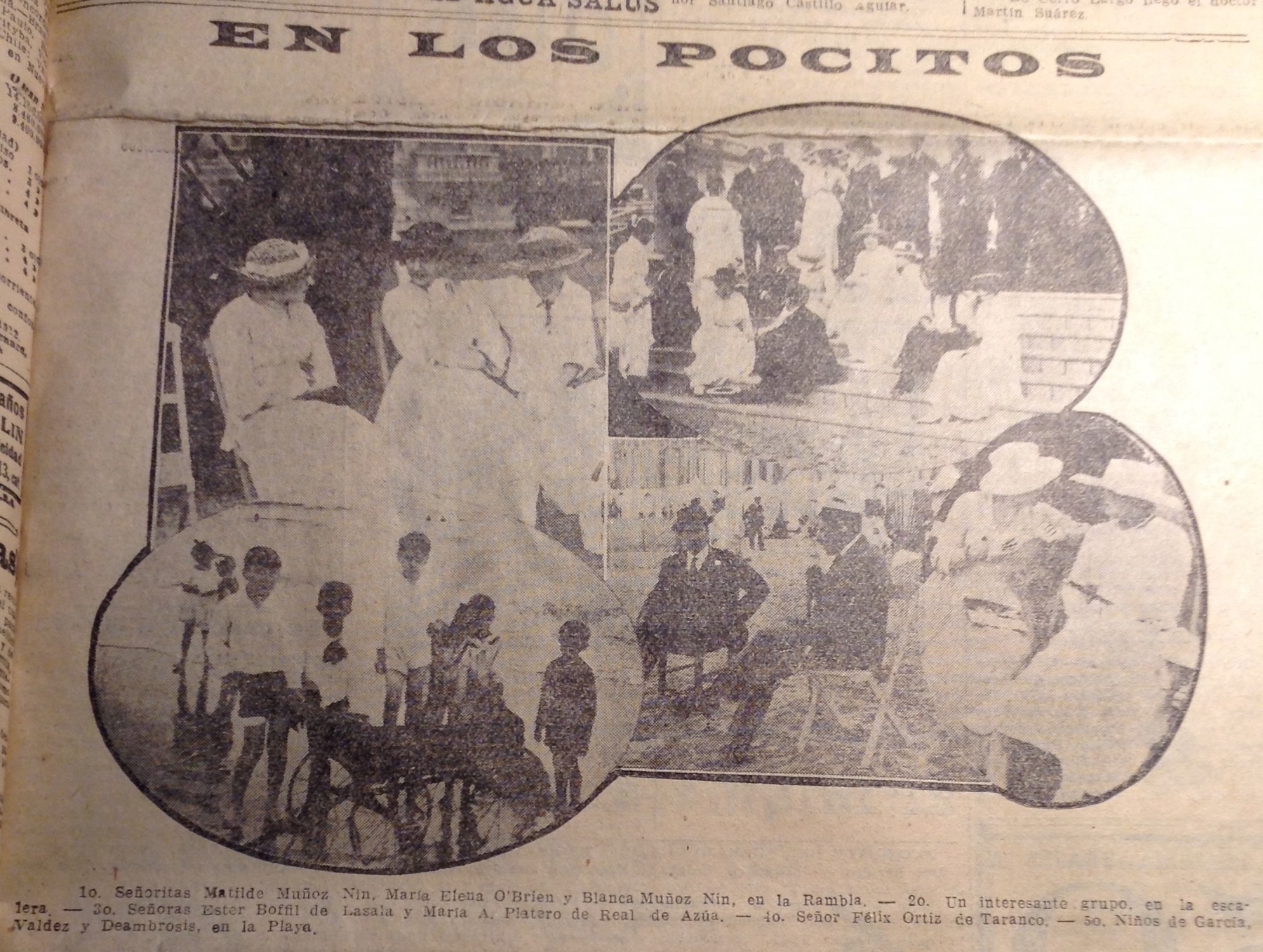
“En los Pocitos.” La Razón (1 February 1918). Like the example discussed in this paragraph, these pictures would later be projected onscreen during the event.
Similarly, in 1918, a committee presided over by Martha Horne Flynn, and featuring many sponsors (all listed in the newspaper announcement), organized a charity screening event at Cine Rex.20“Gran Festival de esta noche en el Rex Cinema.” La Razón (3 May 1918): 3. Unlike the previous example, in this instance, some of the still images that would be projected during the screening also appeared in the society section of the newspaper, signaling their importance in the context of the event. From today’s perspective, the publication of these images also partially preserves this ephemeral charity screening.
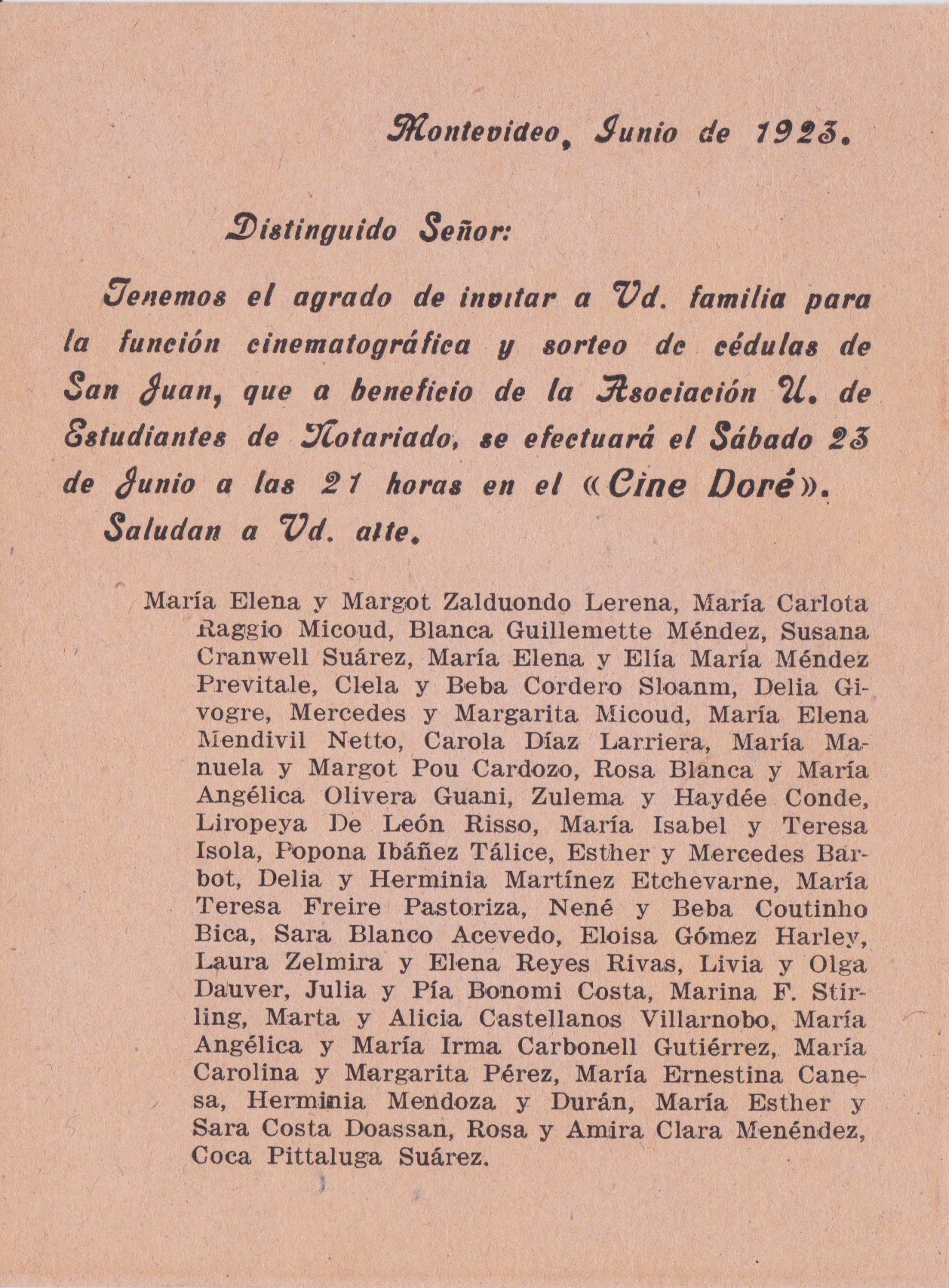
Invitation to a charitable event with the complete list of organizers, June 1923. Private Collection.
It is clear from these two promotional press items, and others like them, that in their fundraising activities, these elite charitable associations not only relied on a combination of moving images and fixed projection, but also that fixed projection was an important part. In the press releases transcribed in the social sections of the newspapers, fixed projections were constantly indicated as the chief attraction at these events (the French word for such an attraction, clou, recurs in the texts) whereas the feature films shown were often not mentioned at all. Aside from the technological benefit of fixed projection—it was likely a practical and cost-effective strategy for charities’ fundraising goals—if we think, particularly, of a female audience to whom these social fundraising exhibitions were generally aimed,21In addition to these charitable associations’ love for the inclusion of lists of the promoters and protagonists of their events, the press started early on to include long lists of spectators’ names. These “pragmatic” lists—to quote Umberto Eco’s book on the subject—were also highly symbolic (then, and for us now) in terms of audience construction, and offered gendered enumerations divided into “Mrs.” and “Miss” (thus, classifying the spectators into “already taken” and “available”). See, “Cine Stella.” La Colonia (2 December 1924): 5; Umberto Eco, La vertigine della lista (Milan: Bompiani, 2009). then the emphasis on fixed projection—both at these events and in the press—functioned as a way for the organizers to manage priorities, highlighting where to look and at what.
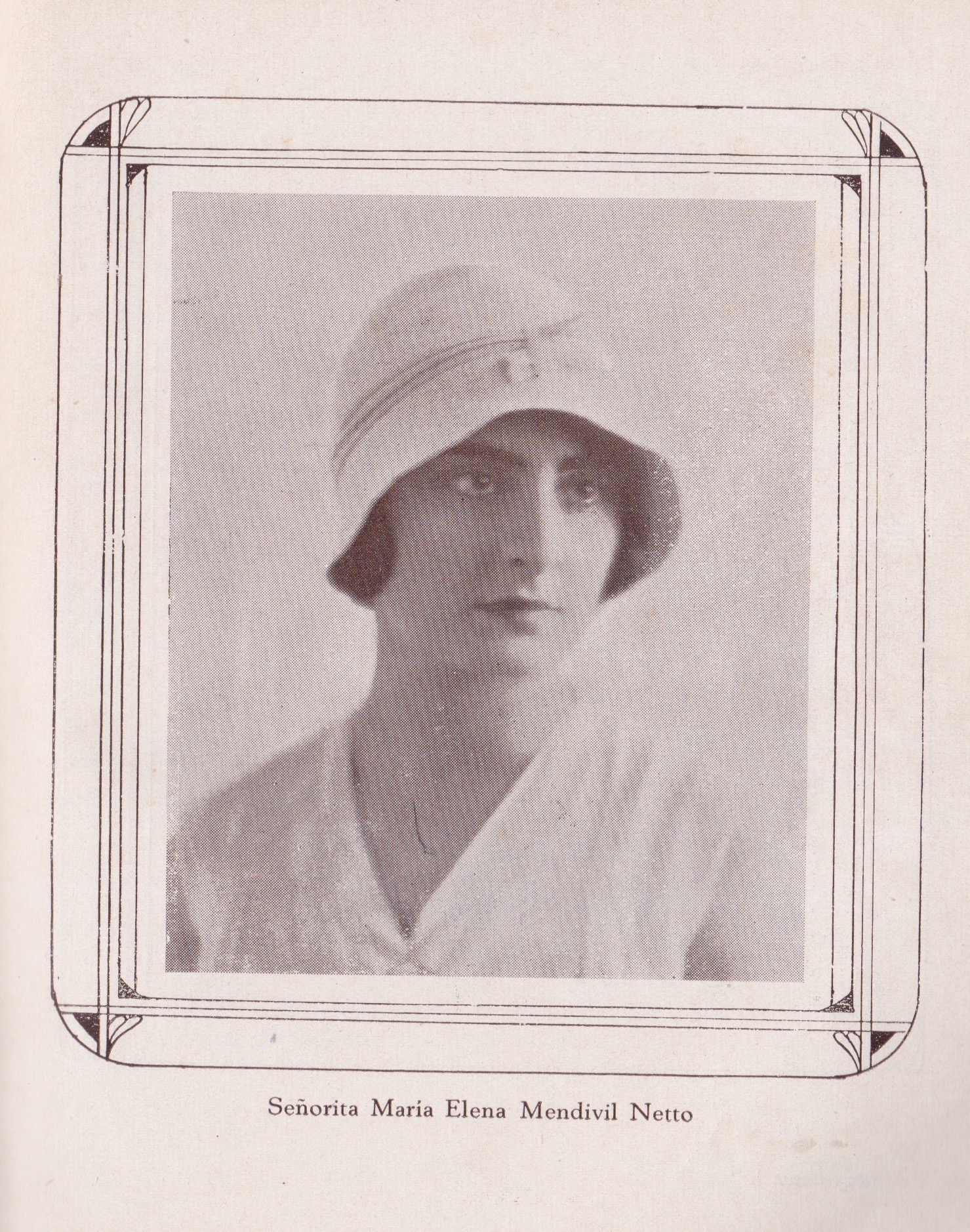
A charity film exhibition organizer, María Elena Mendivil Netto, in Guía mundana del Uruguay VI, 1930-1931.
In other words, these upper-class women publicly associated themselves with cinema rather quickly, shrewdly shaping and using these events and the press around them to also draw attention to themselves, their social status, and their work. As noted above, in addition to projecting still images and screening foreign films, these associations also produced their own actualities, which would also be exhibited at these fundraising events. Although these short films are all presumably lost today, we could imagine their contents thanks to their descriptive titles, which were also published in the press. They ranged from patriotic gatherings and sport activities (e.g., dance of the Pericón Nacional, tennis matches), to walks in the park (in the green Prado neighborhood), and private events (at least two weddings were filmed).22Examples of these first early productions include the Pericón Nacional (“La nota social de hoy.” La Razón [9 November 1915]: 5); Proyecciones del Círculo de Tennis (“Exposición cinematográfica de los matches y concurrencia asistente ayer al festival del Círculo de Tennis.” La Razón [26 May 1916]: 4); Una mañana en el Prado. (La Razón [28 October 1917]: 3); Paseando por el Rosarium (“Cosas de Entre Nous. Impresión de un film.” La Razón [26 August 1918]: 3); Boda Bourdieu-Shaw Pareja (“Por los cines. Viernes del Doré.” La Mañana [26 October 1923]: 2); Boda María Teresa Zumarán Arocena y Hernán Milberg (“Los viernes del Doré.” La Mañana [3 October 1923]: 3). Again, these titles are descriptive. Thus, through the adoption and maintenance of a mixed mode of exhibition that included moving and still images produced by these women, alongside foreign films, these elite women effectively “forced” their way—i.e., their names, faces, bodies, histories, priorities, and everyday activities—onto the screen, cohabiting with the most famous movie stars of the time. To a certain extent, these members of the elite were kind of celebrities. In 1923, for example, a newspaper announced an upcoming photo-shoot for still images that would be projected at the Cine Rialto in Montevideo. By giving the temporal and spatial coordinates of the shoot, the unnamed benefic association (and the press) invited the reader to participate, as a real-life spectator and to see “behind the scenes,” even though the people to be gazed upon were not true cinematic stars, but members of the elite.23“Del Gran mundo. De beneficencia.” La Mañana (25 March 1923): 5. The practice of extensively listing names of the society figures involved in these film exhibitions also enhanced their glamour, a practice that would be maintained during the following decade, both in the press and on printed invitations. Thus, compared to the beginning of the century, when we saw one anonymous fundraiser organizing a projection, by the 1910s and 1920s, lists of female names, detailed event descriptions, and still images appeared regularly in the press, giving the charity events, but especially the women involved in these presentations, a key media visibility, and potentially an escape from the anonymity assigned to their gender in the private sphere.
Charity film exhibition organizers and sponsors: María Elena Larriera, Martha Horne Flynn, María Helena Méndez Previtale, Carolina López Acosta y Lara, Nina de Malherbe Christophersen, Paulina Algorta Camusso, Margarita Sosa Díaz Piñeyrúa, Amelia Belfort Carril, María Angélica Márquez Castro, María Carlota Montaldo De León, Margarita Gallinal, Marta Villegas Suárez, Corina Seré Rucker, María Elena Algorta Guerra, Lolita Rodríguez Ramos, Delia Christophersen Ungo, María A. Requena Lenzi, Elina Penco Ylla, Ana C. Rovira Carve, Irene Munyo, Amalita Maeso de la Torre, Blanca Caravia Guerra, María Teresa Velazco Piñeyrúa, Juanita Saenz, Rosario Requena, Fanny Altamirano Balparda, Helena Gómez Larravide, María Angélica Sienra, Rosa Ferreira Correa, Olga De León Ayala, Estrella Acosta y Lara, María Teresa Piaggio Garzón and Emilia Balparda. María Elena y Margot Zalduondo Lerena, María Carlota Raggio Micoud, Blanca Guillemette Méndez, Susana Cranwell Suárez, Elía María Méndez Previtale, Clela y Beba Cordero Sloanm, Delia Givogre, Mercedes y Margarita Micoud, María Elena Mendivil Netto, Carola Díaz Larriera, María Manuela y Margot Pou Cardozo, Rosa Blanca y María Angélica Olivera Guani, Zulema y Haydée Conde, Liropeya De Leon Risso, María Isabel y Teresa Isola, Popona Ibáñez Tálice, Esther y Mercedes Barbot, Delia y Herminia Martínez Etchevarne, María Teresa Freire Pastoriza, Nené y Beba Coutinho Bica, Sara Blanco Acevedo, Eloisa Gómez Harley, Laura Zelmira y Elena Reyes Rivas, Livia y Olga Dauver, Julia y Pía Bonomi Costa, Marina F. Stirling. Marta y Alicia Castellanos Villarnobo, María Angélica y María Irma Carbonell Gutiérrez, María Carolina y Margarita Pérez, María Ernestina Canesa, Herminia Mendoza y Durán, María Esther y Sara Costa Doassan, Rosa y Amira Clara Menéndez, Coca Pittaluga Suárez.
The 1910s: Cinema, Nation, and Pedagogical Impulses
“With her eyes lost on the screen and the seriousness that ‘the case requires,’ it seems that nothing of what happens around her exists for her…but if you look closely, you will see an imperceptible smile of triumph or of spitefulness […].”24“S.E. el Cine.” La Razón (20 June 1916): 4. These lines were written in 1916 by an anonymous chronicler for “Resonancias Mundanas,” the society section of La Razón, one of the most popular newspapers in Uruguay at the time. With these words, the writer invited the reader to reflect on the female gaze in the movie theater—not any gaze, of course, but the gaze of an upper-class woman to whom the society pages of La Razón were dedicated and directed as readers, describing their recreational activities, the days of receptions at home, the marriages, births, and deaths, and the charity events. In the chronicler’s telling, at first the woman seems immersed in the images on the screen, but a closer look told (and tells us) another story. Everything was a pose, the chronicler insinuated and, observed carefully, her facial gestures imperceptibly revealed that something else was going on in her mind: the female spectator here was, the chronicler continued, “weaving a seduction plot and preparing her combat weapons.” The film, then, would seem like a mere stimulus for an action that would be consummated on an extra-filmic level. Interestingly, the writer avoided a well-established trope in the readers’ imaginary—the seductive power of cinema and its potential dangers, including the specifically feminine prototype of the movie-struck girl25Stamp, Movie-Struck Girls.—to fall into another, equally established one—that of the femme fatale who “plots” seductions and combats. Despite this, the writer was not mistaken when s/he pointed out the strategic gaze this woman (possibly an efficient metonymy for elite women) had toward cinema at that time in Uruguay. For her (for them), the new medium did not seem to have been mere fun to dive into, but a sort of promotional tool as well. A tool to plot and combat, but in the cultural arena.
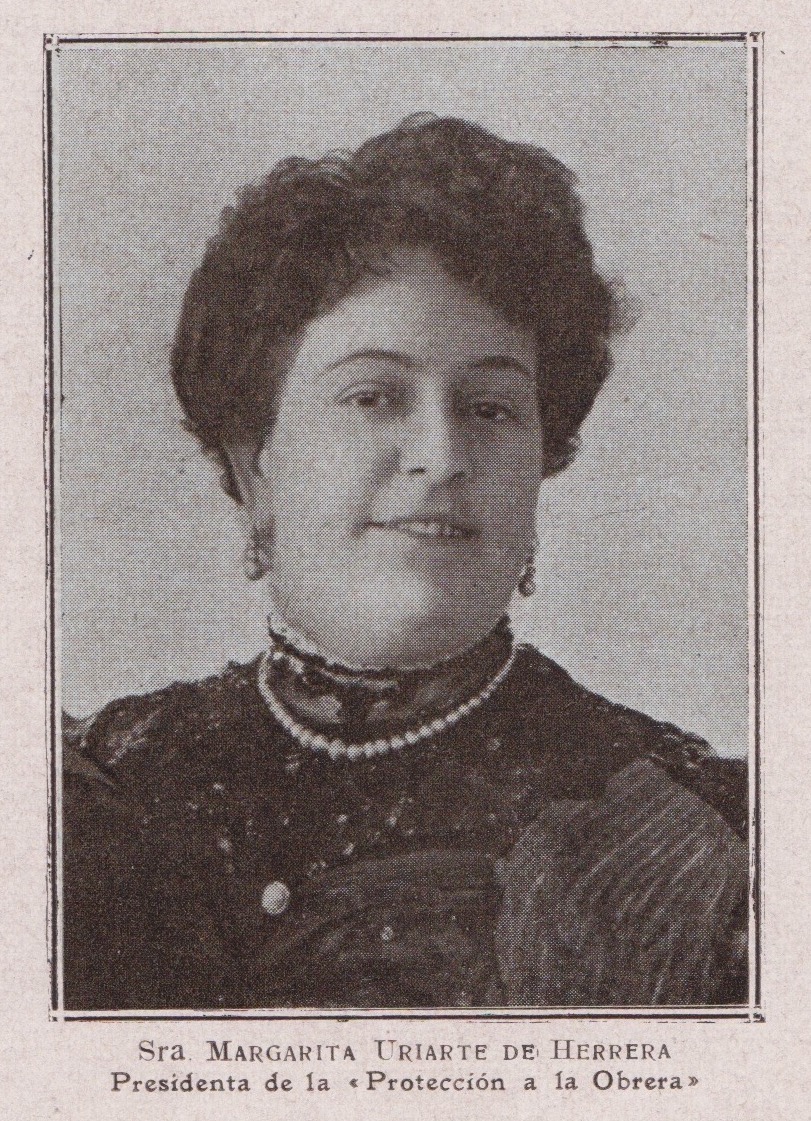
Margarita Uriarte de Herrera in 1920, Anales. Revista nacional, no. 55.
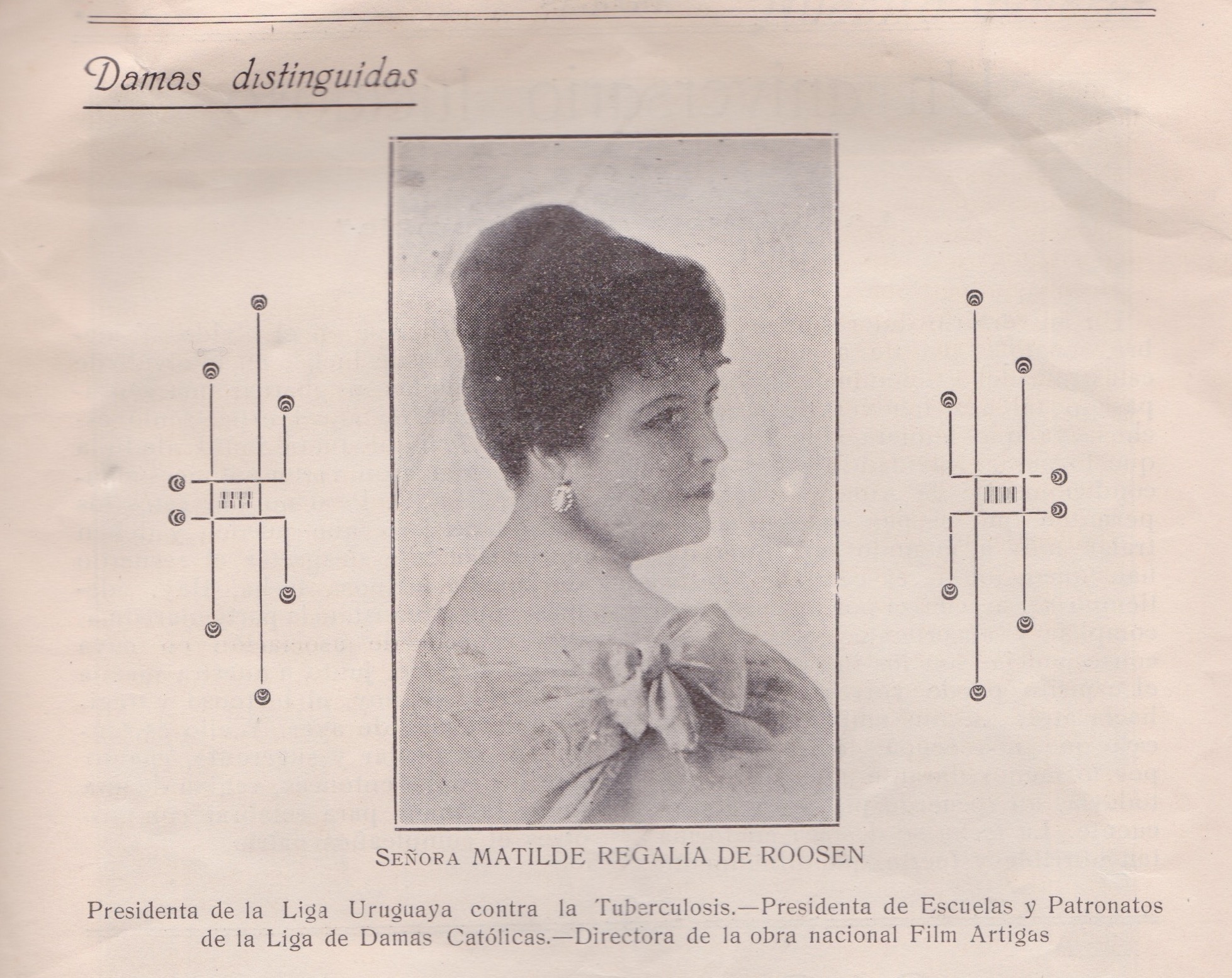
Matilde Regalía de Roosen, Artigas. Revista de informaciones, crónica y actualidades. Órgano de la defensa nacional I, no. 1 (25 August 1915).
Indeed, the first attempt to produce a fiction film in Uruguay, in 1915, was fostered by an elite women’s charity association with nationalistic and educational aims. Although the film, titled Artigas, was never completed, for almost a year news of the project occupied space in the society sections of several newspapers and, therefore, in people’s collective imagination. According to the newspapers, the film was to focus on the life of José Gervasio Artigas, Uruguay’s national hero, and would be interpreted by the descendants of the very patricians who had helped fight for an independent nation. The idea for the film was developed by Margarita Uriarte de Herrera, president of the Ladies Commission of the Committee for Schools and Patronages of the League of Catholic Ladies of Uruguay. Matilde Regalía de Roosen, president of the Uruguayan League Against Tuberculosis, was appointed as the film’s director.26“Damas distinguidas.” Artigas. Revista de informaciones, crónica y actualidades. Órgano de la defensa nacional I, no. 1 (25 August 1915). The choice of Regalía de Roosen as director was particularly significant: on the one hand, she was part of a lineage of patricians and, therefore, could ideally direct the story with insider information. On the other hand, her connection with cinema dated back to the beginnings of the new medium. In fact, the first Lumière screening in Uruguay, in July 1896, was held at her family home, Casa Roosen, which was soon converted into Montevideo’s first movie theater, the Salon Rouge.27“El cinematógrafo.” El Día (21 July 1896): 1. See “Nuestra primera sala cinematográfica. Salón Rouge.” Álvaro Sanjurjo Toucon. http://www.uruguaytotal.com/salon_rouge/index.html.
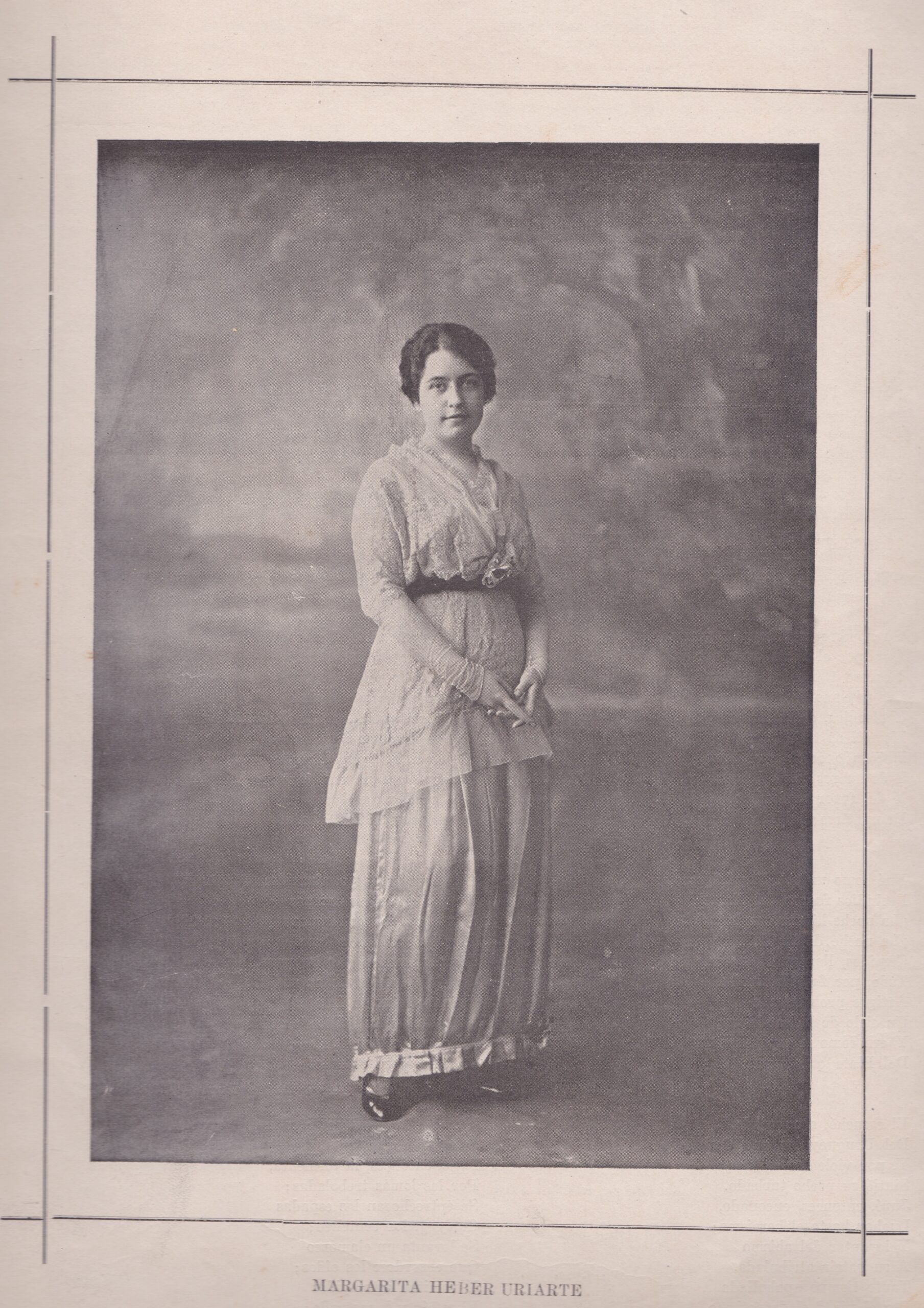
Margarita Heber Uriarte in Tabaré. Revista Literaria vol. 1, no. I (July 1914).
As a project, Artigas was well received by the community, and was assured a significant budget. The press reported several details about it: the script would be written by two renowned authors, Juan Zorrilla de San Martín, already considered by 1915 to be the preeminent national poet, and Raúl Montero Bustamante; the music would be played by the very popular César Cortinas orchestra; and the production would be completed by the largest producer and distributor of the time, Max Glücksmann’s Casa Lepage.28For more on this project, see Georgina Torello, “Artigas: gestación y fracaso de un proyecto cinematográfico.” In La pantalla letrada: estudios interdisciplinarios sobre cine y audiovisual latinoamericano, eds. Georgina Torello and Isabel Wschebor (Montevideo: Universidad de la República, 2015): 49-61; then expanded in Torello, La conquista del espacio, 57-72. This list of male participants is noteworthy as it highlights how these upper-class women were able to establish productive agreements with important artists and entrepreneurs of the time in order to make their film. While the actor playing Artigas was never announced, the organizers did disclose the actress chosen for the female role: Margarita Heber Uriarte, one of the “protagonists” of the social scene whose portrait often appeared in magazines.29At the time, cultural magazines, and even literary magazines, included “society news pages” with numerous photographs taken at social events and studio portraits of the elite. The most relevant of these magazines, since its first issue published in 1915, was Anales Mundanos (then Anales Revista Nacional). The magazine, a lavish publication, was aimed at a readership of elite women since very elegant portraits of socialites like Margarita Heber Uriarte filled its pages. As Juan Antonio Varese has pointed out, the magazine indulged these socialites’ vanity: Anales “did not have an edition date so that the age of women of lineage who were portrayed could not be calculated.” See, Juan Antonio Varese, “Fotografía en los años veinte: la popularización de la imagen.” In Los veinte: el proyecto uruguayo; arte y diseño de un imaginario 1916-1934, ed. Gabriel Peluffo Linari (Montevideo: Museo Municipal de Bellas Artes Juan Manuel Blanes, 1999), 139. Anales serves as an indicator of the public relevance of many of these women and is an indispensable, and often unique, iconographic source for scholars and for my present purpose (to make women’s names, but also their bodies) present. Although many of the portraits illustrating this essay were taken from Anales, for Margarita Heber Uriarte, I selected one from Tabaré. Revista Literaria. This photo, published not long before Artigas was conceived, shows her in full body, looking confidently at the photographer, in a studio with the standard painted landscape backdrop. Like the other portraits here, this one shows her at ease with the medium, in what we can assume is a picture taken for public viewing.
Towards the end of 1915, Artigas was abandoned without any public explanation and was never taken up again. Regardless of the project’s abrupt termination, its very existence embodies the beginning of fiction filmmaking in Uruguay. It also forces us to think about the first connections between cinema, fiction, national history, and patriotism, putting female agency in the foreground (as it should have always been) and answering, at least partially, the question of who would be in charge of these narratives. Furthermore, it establishes a clear link between cinema and pedagogy, since, as one newspaper claimed, the film would be of “great educational interest for the formation of our young students because it is well known that it is not as easy to admire heroes in patriotically enthusiastic sentences than it is to see them move and throb at the impulse of that same high feeling; nor to study a moment in history than to see it unfold before the eyes.”30“Una bella iniciativa. El film Artigas. Preparativos.” La Razón (15 January 1915): 4.
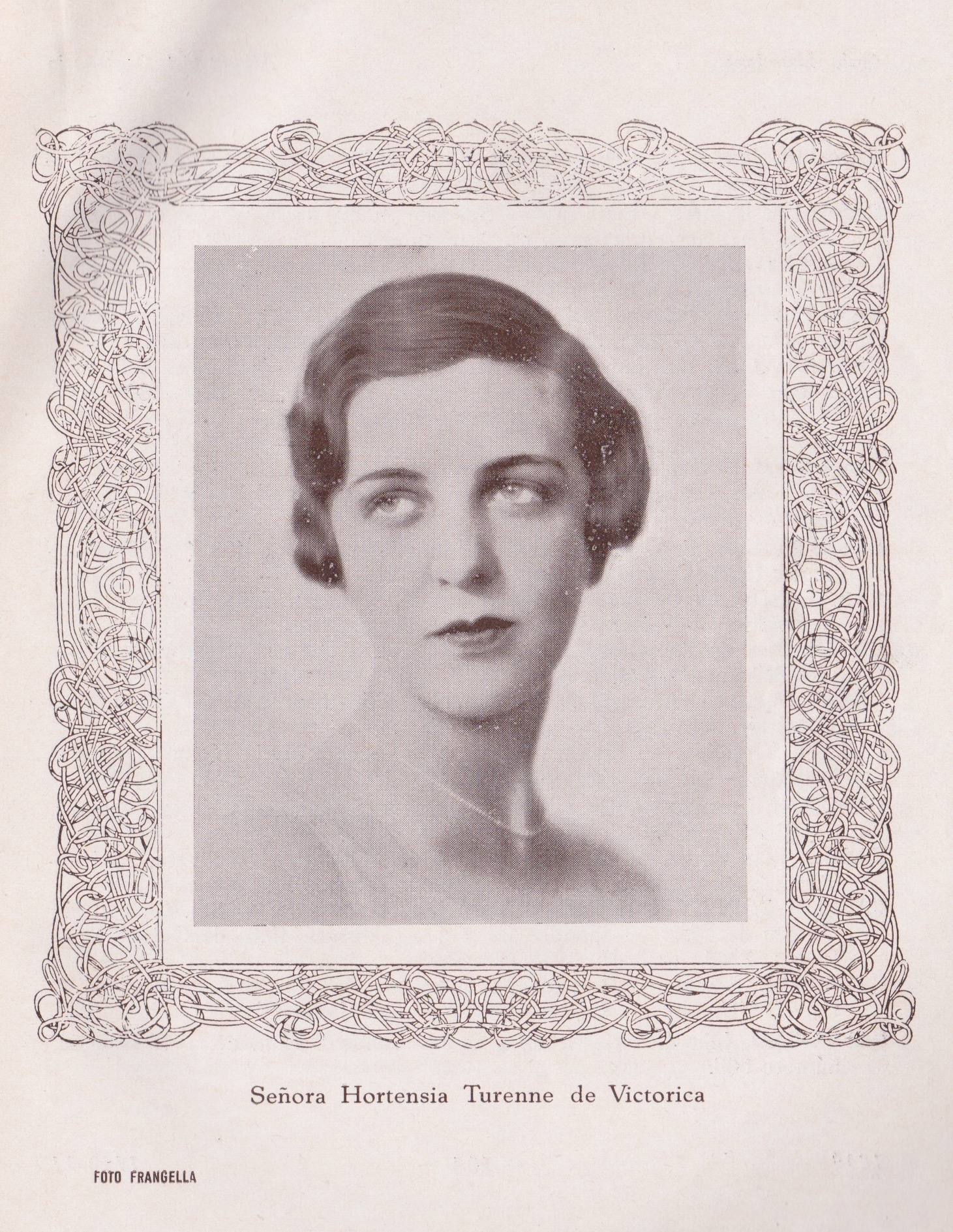
Hortensia Turenne de Victorica in Guía mundana del Uruguay VI, 1930-1931. In 1917, her name was Hortensia Turenne Puig and she was one of the members of the Child Protection Committee.
The unproduced film’s potential pedagogical effect paralleled the discussions around the relationship between cinema and childhood, which, precisely in the early 1910s, began to proliferate in the country, either to demonize cinema or to distinguish between good and harmful applications of the medium. Significantly, cinema was mentioned in 1913 for the first time in the report of the Theater Censorship Commission compiled by the League of Catholic Ladies of Uruguay, led by Laura Carreras de Bastos.31Magdalena Broquetas and Inés Cuadro Cawen, “Del arte juzgado o defensa de la moral católica. Estudio de la Comisión de Censura Teatral de la Liga de Damas Católicas del Uruguay (1907-1916).” Facultad de Humanidades y Ciencias de la Educación, Montevido, 2001. I thank the authors for giving me access to this unpublished article. In it, Carreras de Bastos begged upper-class women to “draw the attention of Uruguayan mothers to the dangers that cinematography embodied for children’s brains.”32Laura Carreras de Bastos, Pro-arte dramático. Clasificación de las obras estudiadas por la Comisión de Censura Teatral de la Liga de Damas Católicas del Uruguay (Montevideo: la Liga de Damas Católicas del Uruguay, 1916): 76. A detailed study of the impact of the League in the field of cinema has not been done and it is much needed. La Liga was not alone in this crusade because, even outside religious spheres, there was a general interest in regulating and censoring film exhibitions for children. Nevertheless, by 1915, much of the elite charity sphere understood that regulations should not prevent the use of cinema as a pedagogical tool.33See “El biógrafo y los niños. Al margen de un proyecto.” La Razón (14 April 1915): 1; Enrique Reyes, “Por los niños. Las exhibiciones cinematográficas. Opinión de un distinguido educacionista.” La Razón (15 April 1915): 1; “Las películas morbosas. Principio de saneamiento.” La Razón (7 October 1915): 1. Even the Child Protection Committee itself, headed by Gladys Shaw, established, by 1917, agreements with businessman Max Glücksmann to program children’s matinees.34“Committee for the Protection of Children.” La Razón (13 November 1917): 4. The committee members were: Gladys Shaw, Julia Muñoz Nin, Magdalena and Lucila Lussich Siri, Susana Soca Blanco, Helena Hughes García Lagos, Hortencia de Herrera Uriarte, Maria Cecilia Etchepare Herrera, René Pietracaprina Méndez, María Celia and Elida Schiaffino Espalter, Hortensia Turenne Puig, Sarita Durán Guani, Inah Mañé Azevedo, Adelita and Isolina Castels Eastman, Martha and Mirta Beherens Muñoz, Maria Hortensia Serratosa Carvalho, Amelia, and Sara Méndez Schiaffino, Emita and Elina Capurro Castels, Glady, Castellanos Cranwell, Albertina Deluchi Turenne, María D., Elisa Nocetti Mullins, Sara and Laura Lussich Márquez, Martha and Raquel Zás Allende, Rosita Piccardo Ruano, María Celia Gallinal Risso, Blanquita Blanco Hughes, Blanquita and Elba Pérez Castels, Emita Seré Rücker, Delia and Susana Pascual Castellanos, Coquita Regalia Muller, Marujita Seré Castellanos, Margarita Sienra Castellanos, Cristina Mourelle Ruano, Beba and María M. Ponce de León, Nilza L., Lida E. Díaz Ayala, María C. Gómez. It is clear, then, that the development of Artigas fit into the elite’s broader interest in (first and foremost) exploiting the cinema to raise interest (and money) for their enterprises, but also as a way to showcase their own kin, (re)write the past and present of their country, and educate younger generations through the reinforcement of a certain set of patriotic and cultural values.
Planned producer, director, and actress for Artigas; pedagogues and committee members: Margarita Uriarte de Herrera, Matilde Regalía de Roosen, Margarita Heber Uriarte, Laura Carreras de Bastos, Gladys Shaw, Julia Muñoz Nin, Magdalena and Lucila Lussich Siri, Susana Soca Blanco, Helena Hughes García Lagos, Hortencia de Herrera Uriarte, Maria Cecilia Etchepare Herrera, René Pietracaprina Méndez, María Celia and Elida Schiaffino Espalter, Hortensia Turenne Puig, Sarita Durán Guani, Inah Mañé Azevedo, Adelita and Isolina Castels Eastman, Martha and Mirta Beherens Muñoz, Maria Hortensia Serratosa Carvalho, Amelia, and Sara Méndez Schiaffino, Emita and Elina Capurro Castels, Glady, Castellanos Cranwell, Albertina Deluchi Turenne, María D., Elisa Nocetti Mullins, Sara and Laura Lussich Márquez, Martha and Raquel Zás Allende, Rosita Piccardo Ruano, María Celia Gallinal Risso, Blanquita Blanco Hughes, Blanquita and Elba Pérez Castels, Emita Seré Rücker, Delia and Susana Pascual Castellanos, Coquita Regalia Muller, Marujita Seré Castellanos, Margarita Sienra Castellanos, Cristina Mourelle Ruano, Beba and María M. Ponce de León, Nilza L., Lida E. Díaz Ayala, María C. Gómez.
Charity as a Pioneer of Fiction: Pervanche (1920)
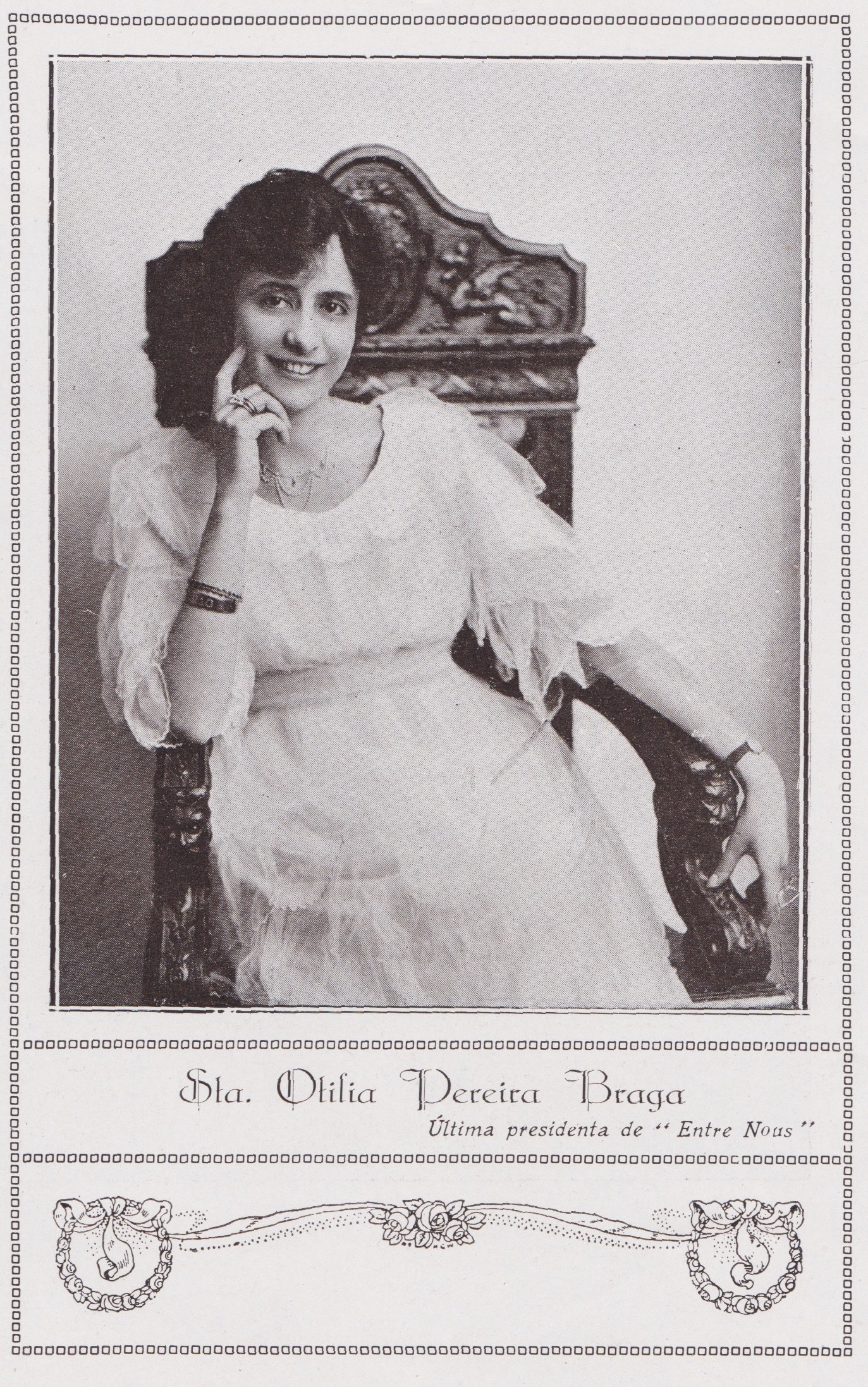
Otilia Pereira Braga in 1920 in Anales. Revista nacional, no. 53.
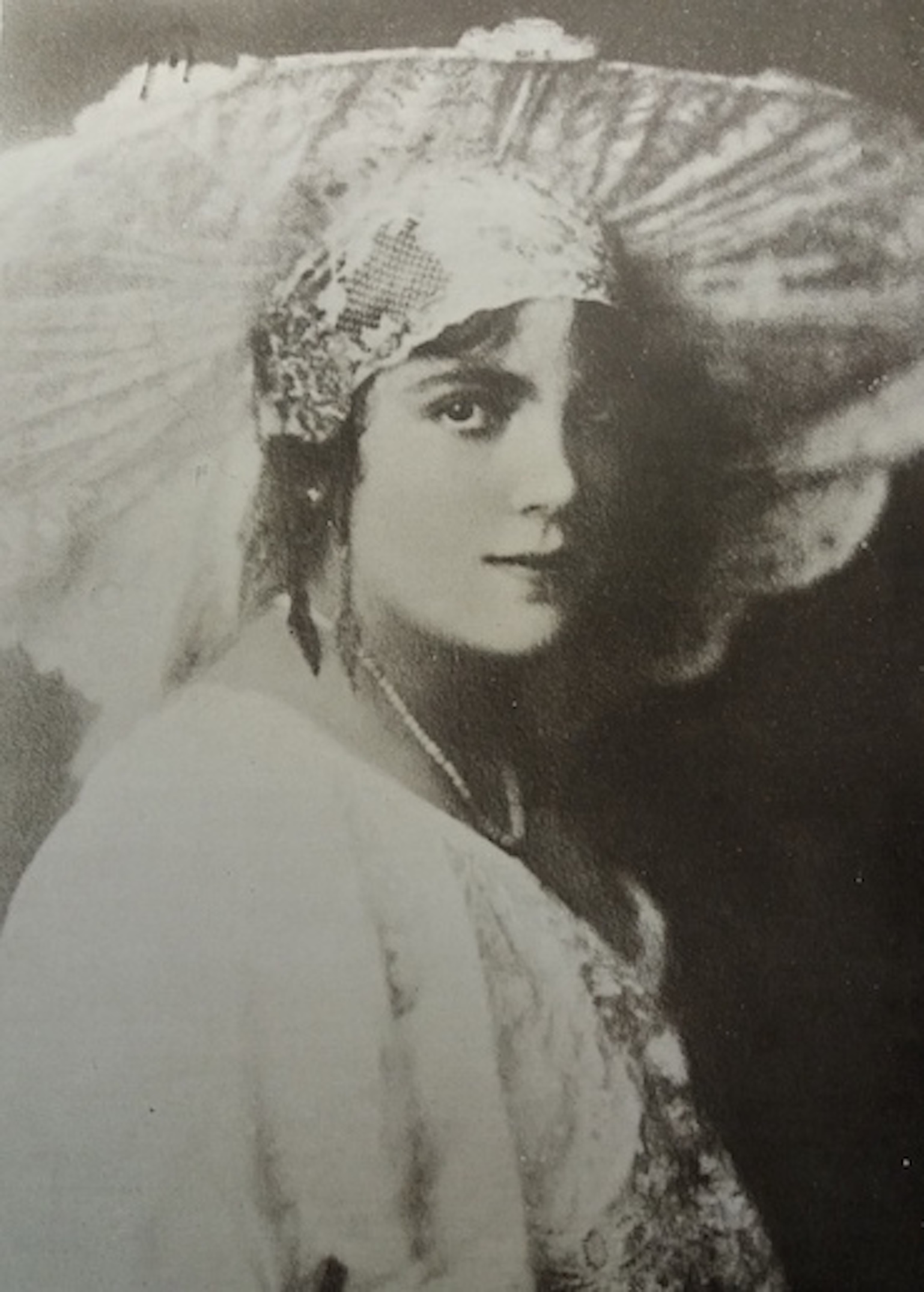
María Magdalena Villegas Márquez in Selecta 1, no. 7 (November 1917).
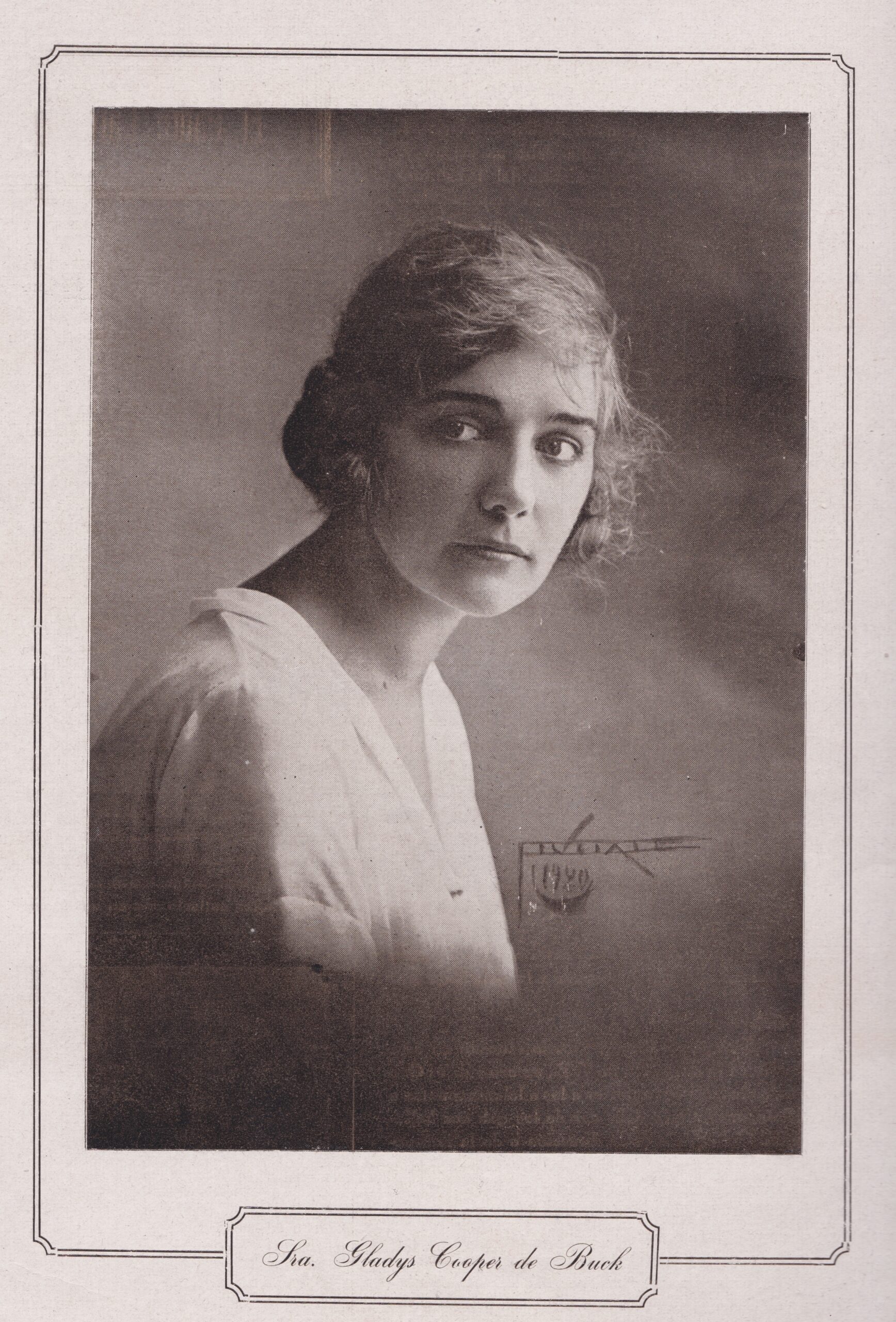
Gladys Cooper de Buck in Anales. Revista nacional, no. 52.
The cinematic ambitions of charity groups—and Uruguayan fiction filmmaking tout court—were met in 1920 with Pervanche, a production of the aforementioned female association Entre Nous, led by Otilia Pereira Braga. The film, presumed lost today, was based on a screenplay outlined by María Magdalena Villegas Márquez, a member of Entre Nous, and one of the film’s protagonists, along with Gladys Cooper de Buck.35The rest of the female cast included Margarita Savedra Barrozo, María Isabel Moreno, Elvira Mousques, Elisa Vargas, and María Guerrero. While Pervanche’s title referred to the almost homonymous novel Pervenche (1904) by the famous female French writer Gyp, the film’s plot was an adaptation of Mademoiselle de la Seiglière (1848) by Jules Sandeau, and contained all the basic ingredients of melodrama: the decline of a wealthy family, a dangerous love triangle, and a happy ending with a marriage. The film premiered at the Teatro Solís, the most lavish venue of the capital. It was directed by León Ibañez Saavedra, and featured members of the Uruguayan elite.36After the film’s premiere, very detailed lists of spectators’ names were published in the press. Interestingly enough, one of them contained, together with the female audience listed, a brief description of their attire (color and fabric). This list worked as an efficient medium of self-promotion, but also functioned as an upcoming fashion show for women outside the elite. “To give a complete list of the people who attended this event would be impossible, we’ll mention only the ones that we were able to write down in our chroniclers’ card, as well as the gowns that attracted the most attention: Ladies: María E. Christophersen de Puig, was in black tulle; María Elena Uriarte de Montero, in charmeuse and blue tulle; María Magdalena Villegas de Souza, in black silk, colored flower; Elena Alvarez de Calamet in brick-colored gauze, Elisa Ferrando de Birabén, in purple gauze […].” “El festival de anoche.” La Mañana (12 June 1920): 2.
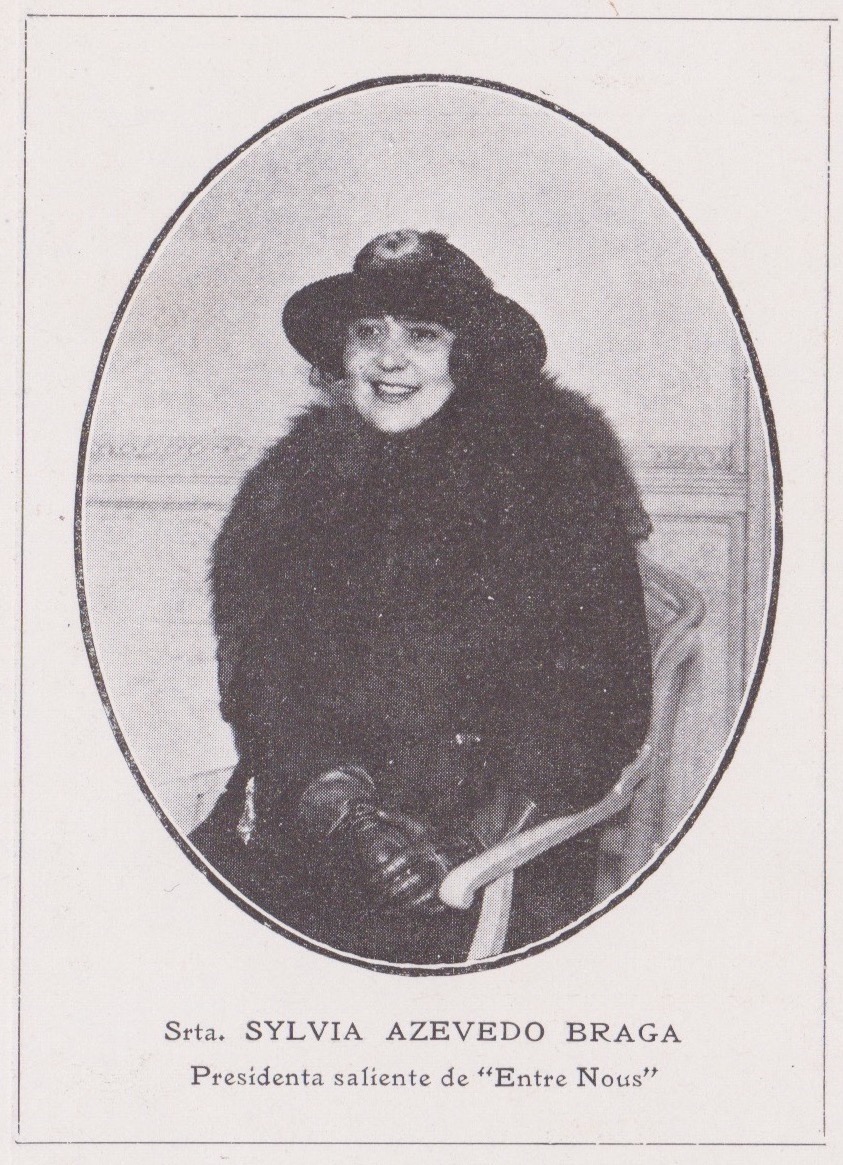
Sylvia Azevedo Braga c. 1919 in Anales. Revista nacional, no. 43.
Pervanche was not the first attempt by Entre Nous to produce a fiction film. (The organization also produced actualities, as discussed earlier.) In fact, in September 1918, the society section of La Razón announced that, under the banner of the association, a local author would write a comedy and members of the elite would be in charge of the performances.37“Cosas de Entre Nous. Impresión de un film.” La Razón (13 September 1918): 3. By November, it was stated that the script would be written by a “distinguished and intelligent lady, a prominent figure in the literary milieu” whose name, perhaps titillating readers’ curiosity, was not given.38“Cosas de Entre Nous. Impresión de un film.” La Razón (20 November 1918): 3. It was also reported that production would start as soon as Sylvia Azevedo Braga, President of the Club, returned from Rio de Janeiro.39“Cosas de Entre Nous. Impresión de un film.” La Razón (5 December 1918): 3. Yet, by December, when she was back in Montevideo, as stated in the press, the project was abandoned. Even if there are some coincidences that would suggest—given the recurrence of Entre Nous and the “Braga” surname in the two projects—that the project from 1918 was Pervanche itself, what seems important here is the maintained interest, within the association, in filmmaking (both actualities and fiction) in addition to their film exhibition practices as well as their faith in the power of the medium.
From the few stills available, and from the coverage in the press, we know that, in addition to following foreign narrative tropes, Pervanche was intended to create a very precise image of Uruguay, and its capital. The story depicted Montevideo as a modern and cosmopolitan city, an image of the city that other media, such as postcards or magazines, had previously presented. That is to say, the city where the elite circulated (urban areas and parks), and where it lived (the film showed several of the city’s most beautiful palaces). Pervanche built a fragmented and exclusive discursive map, but it also, at least symbolically, invited the general public to voyeuristically “enter” that world, and rub shoulders with and observe the ways and fashions of the elite. In this way, the film not only functioned as a means of self-representation for the upper class, a practice already established at events and in the press as I have shown; it was also a form of self-representation that, under the guise of a fiction film, was perhaps more glamorous, immediate, and powerful than the actualities or static pictures, and one in which its elite makers had more conscious control.
Pervanche producers, script writers, and actresses: Otilia Pereira Braga, María Magdalena Villegas Márquez, Gladys Cooper de Buck, Margarita Savedra Barrozo, María Isabel Moreno, Elvira Mousques, Elisa Vargas, María Guerrero, Sylvia Azevedo Braga.
Intellectuals and Cinema
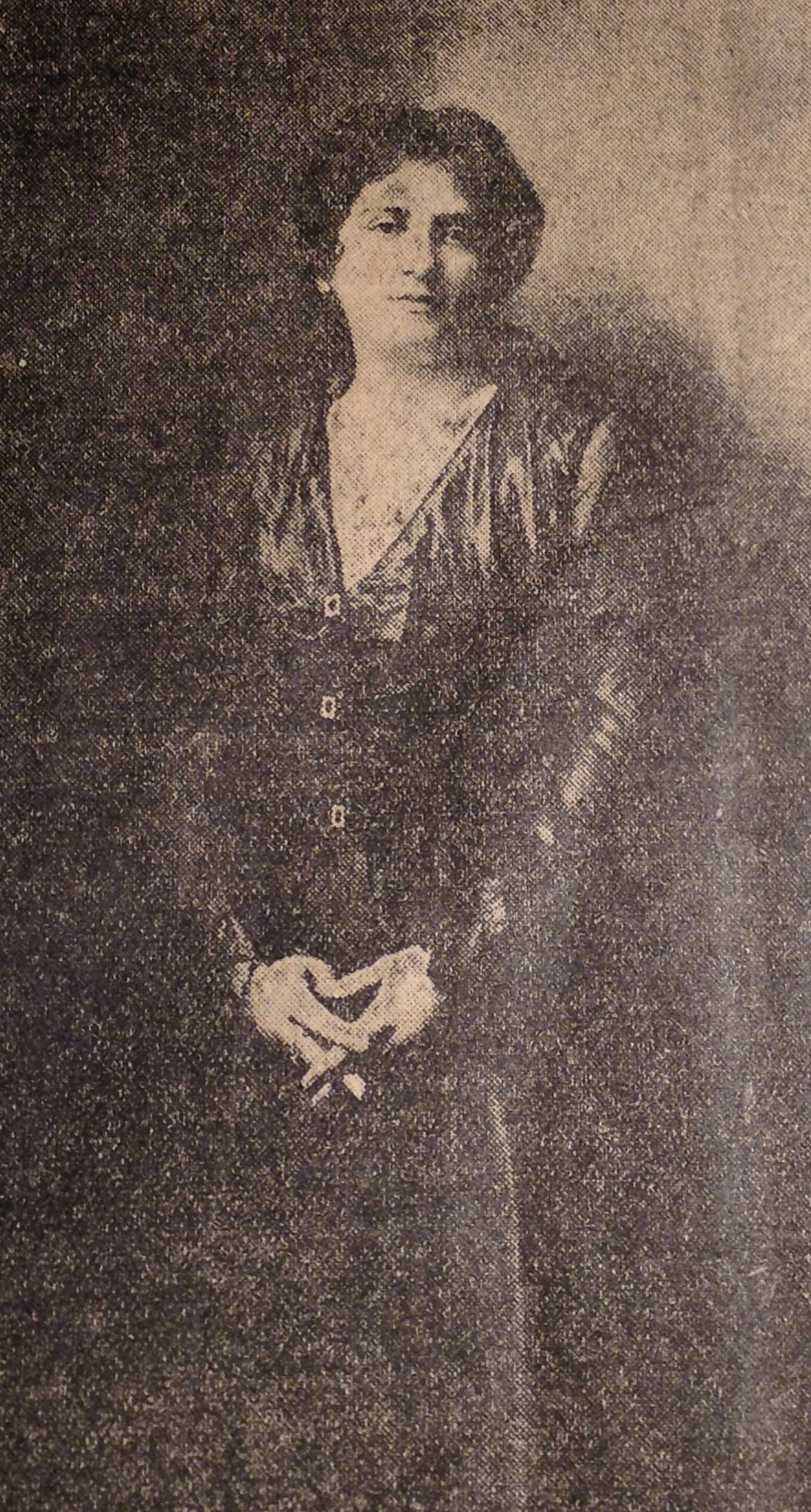
Fabiola in La Razón (3 March 1919).
Criticized for its technical imperfections, Pervanche was defended by a renowned social activist, journalist, and writer: Fabiola, the pseudonym of middle-class writer Teresa Santos de Bosch.40Fabiola (Teresa Santos de Bosch), “Pervanche.” La Razón (14 June 1920): 1. In her response to the criticisms of the film, she associated economic precariousness and aesthetic results, pragmatically establishing the need to think about film production from the periphery, and with the resources of the periphery. Her article intelligently transcended the “merely” aesthetic questions in favor of an analysis that pinpointed, as the main problem, the difficulties for marginal markets to produce films. In short, her discourse assumed that Uruguayan cinema could only be called what later film historians have articulated as a cinema of a “small nation.”41Mette Hjort and Duncan Petrie, eds., The Cinema of Small Nations (Edinburgh: Edinburgh University Press, 2007). And, because of that, she suggested that critics should adapt their notions according to the country’s economic and material conditions in order to promote a much-needed development of the industry. Fabiola’s review of Pervanche in 1920 thus constitutes the first articulate and lucid discourse on the question of critical reception and national cinema in Uruguay.42 For further analysis of her article, see Georgina Torello, “‘Han llegado hasta mí ecos de críticas tan injustas.’ Notas sobre cine silente.” In La crítica uruguaya ante el cine nacional (1920-2001), eds. Mariana Amieva and Germán Silveira (Montevideo: Yaugurú, 2021): 23-40. It is also worth mentioning that Fabiola gave, in 1915, a lecture at the Ateneo of Madrid about Uruguay and Uruguayan women, and that she used projections during her speech. (It is unclear whether these were still or moving images.) See Ángeles Ezama Gil, Las musas suben a la tribuna. Visibilidad y autoridad de las mujeres en el Ateneo de Madrid (1882-1939) (Madrid: Geneuve Ediciones, 2018): 146.
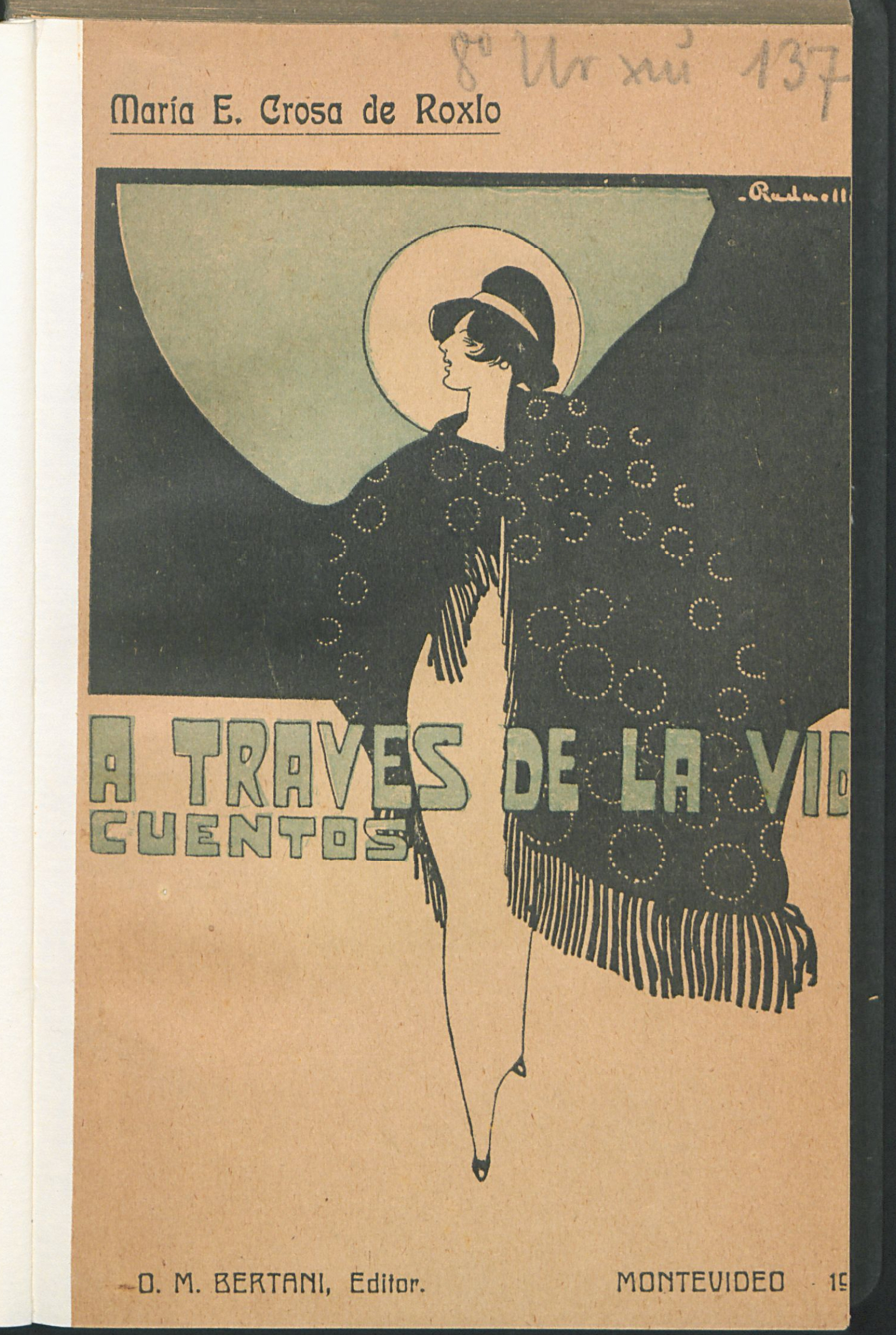
María Elena Crosa de Roxlo, A través de la vida (Montevideo: Bertani, 1913).
Fabiola was not the first female writer who dealt publicly with cinema. María Elena Crosa de Roxlo, in her collection of stories entitled A través de la vida/Through Life (1913) included one called “La cinta cinematográfica,” or “The Film.”43María Elena Crosa de Roxlo, A través de la vida. (Montevideo: Bertani, 1913). See Martina Bertone, “Escribir sobre el cine: María Elena Crosa de Roxlo, una pionera uruguaya.” Sotobosque. https://www.sotobosque.uy/post/literatura-crosa. In it, Crosa de Roxlo—a long forgotten writer—developed an exciting plot that fused medicine, hypnosis, and control over the female body, although she never mentions the “film” of the title. However, the title is a crucial piece of “para-text” that necessarily frames the reading: it is like declaring that everything that happens in the story, printed on paper, is “film” material. “La cinta cinematográfica” is therefore a specimen of the early association, and possible intersection, of cinema and literature in Uruguay. The book came out precisely when European film producers consolidated their melodramatic and diva film narratives and massively exported their products to Latin America. These films would soon become hegemonic in the continent, at least until the First World War; Crosa de Roxlo’s story was perfectly timed, as Uruguayan audiences were very much attuned to this kind of intricate plot on the screen. Another liaison between women, literature, and cinema was established by Edgarda Cadenazzi—an extraordinary figure of avant-garde writing—in her long “Poema en serio a Carlitos Chaplin,” or “A serious poem to Charlie Chaplin” (1928), in which she offered a labyrinthine and “modern” portrait of Charles Chaplin.44Edgarda Cadenazzi, “Poema en serio a Carlitos Chaplin.” Vanguardia 1 (September 1928). Her voice joined those of other avant-garde Latin American writers, mostly men, who regarded the actor as a paradigm of dissent functioning at the very heart of the United States film industry.45Jason Borge, Avances de Hollywood. Crítica cinematográfica en Latinoamérica, 1915-1945 (Buenos Aires: Beatriz Viterbo, 2005). While more conventional, production-oriented film historiographies would perhaps ignore Fabiola, Crosa de Roxlo, and Cadenazzi’s respective critical and literary work, I mention them here to foreground the different ways that some Uruguayan women outside of the upper class actively engaged with cinema and film culture during the silent era.
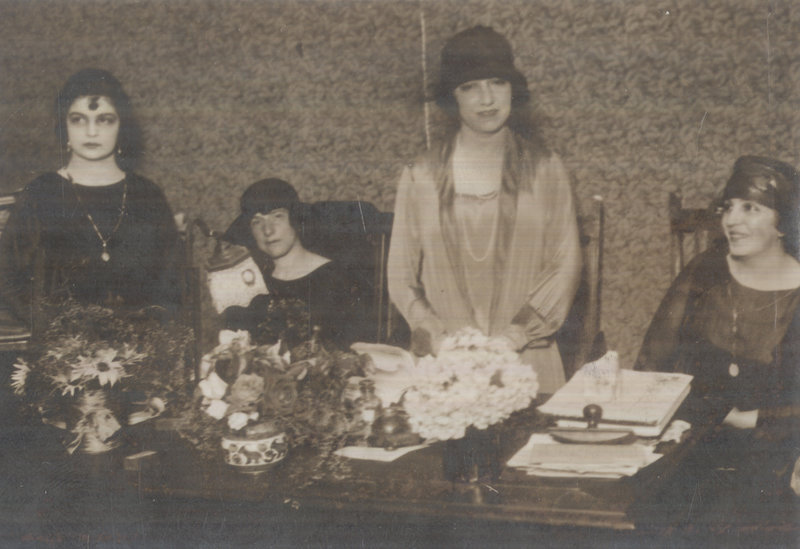
Poet Juana de Ibarbourou (standing with hat). Courtesy of the Biblioteca Nacional de Uruguay.
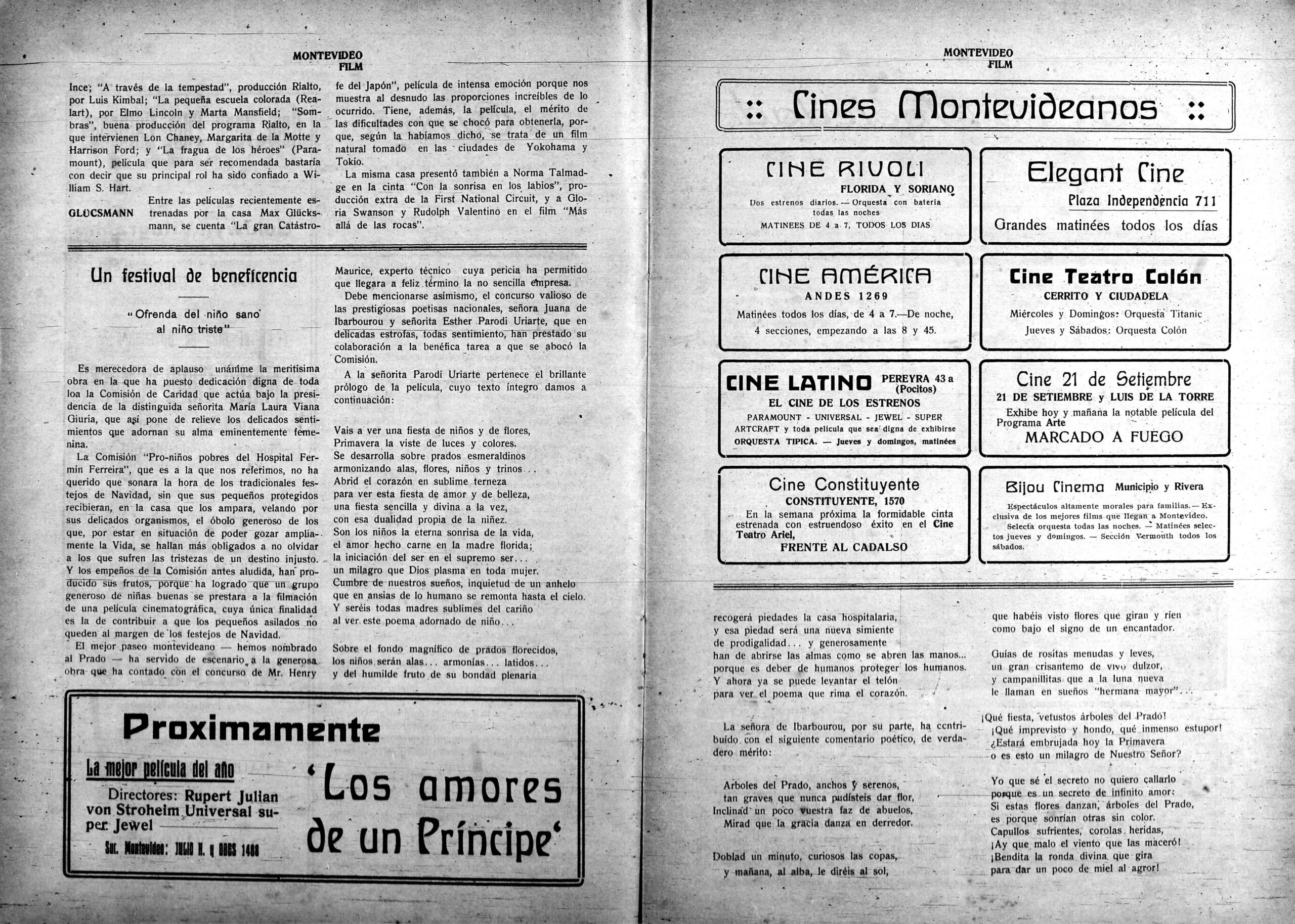
“Un festival de beneficencia.”Montevideo Film I, 2 (6 November 1923). Courtesy of Biblioteca Nacional de Uruguay.
When considering the relationship between female intellectuals and writers and cinema, it is also worth mentioning another charity project. In 1923, The Committee for the Support of the Fermín Ferreira Poor Children’s Hospital, run by María Laura Viana Giuria, produced a short scenic film about a park in the Prado neighborhood.46“Un festival de beneficencia.” Montevideo Film I, no. 2 (6 November 1923). The magazine Montevideo Film, which announced the production, is a very significant resource since it exclusively targeted female readers, even in such a small market, showing the importance this group had locally in the 1920s. This can be easily corroborated by other ephemera, such as invitations to film events, often patently aimed at women. For the occasion, two poets, Juana de Ibarbourou and Esther Parodi Uriarte, offered their verses for the intertitles. Whereas no chronicle of the screening was given in the press, the magazine Montevideo Film published these women’s poems, highlighting the importance of the poetic contributions to this project.47“Un festival de beneficencia.” The actuality, shot by the French cameraman Henry Maurice, was set in the Prado, one of the greenest and most beautiful neighborhoods in the city, and apparently featured children. “You are going to see a festival of children and flowers/Spring of lights and colors/It takes place on emerald meadows/harmonizing wings, flowers, children and trills,” announced the prologue of the film, written by Parodi Uriarte. The main park of the neighborhood was itself the theme of Ibarbourou’s “poetic commentary.”48This park, an example of cosmopolitan beauty with its lakes, rose gardens, fountains, and statues, was one of the favorite film locations during the silent period, both in fiction and in documentaries. While Fabiola, Crosa de Roxlo, and Cadenazzi’s critical and literary work described above suggests that the cinema was a theme or topic for some female intellectuals and writers, Ibarbourou and Parodi Uriarte’s poetic contributions to this film project perhaps suggest that cinema was also a medium with which to further their particular artistic practice.
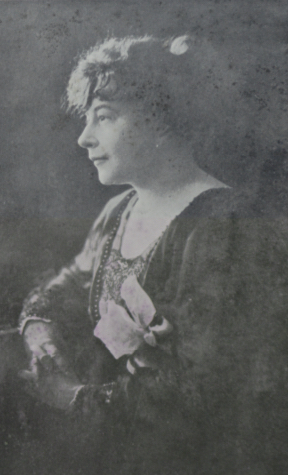
Intellectual and writer Luisa Luisi. Courtesy of the Biblioteca nacional de autores uruguayos.
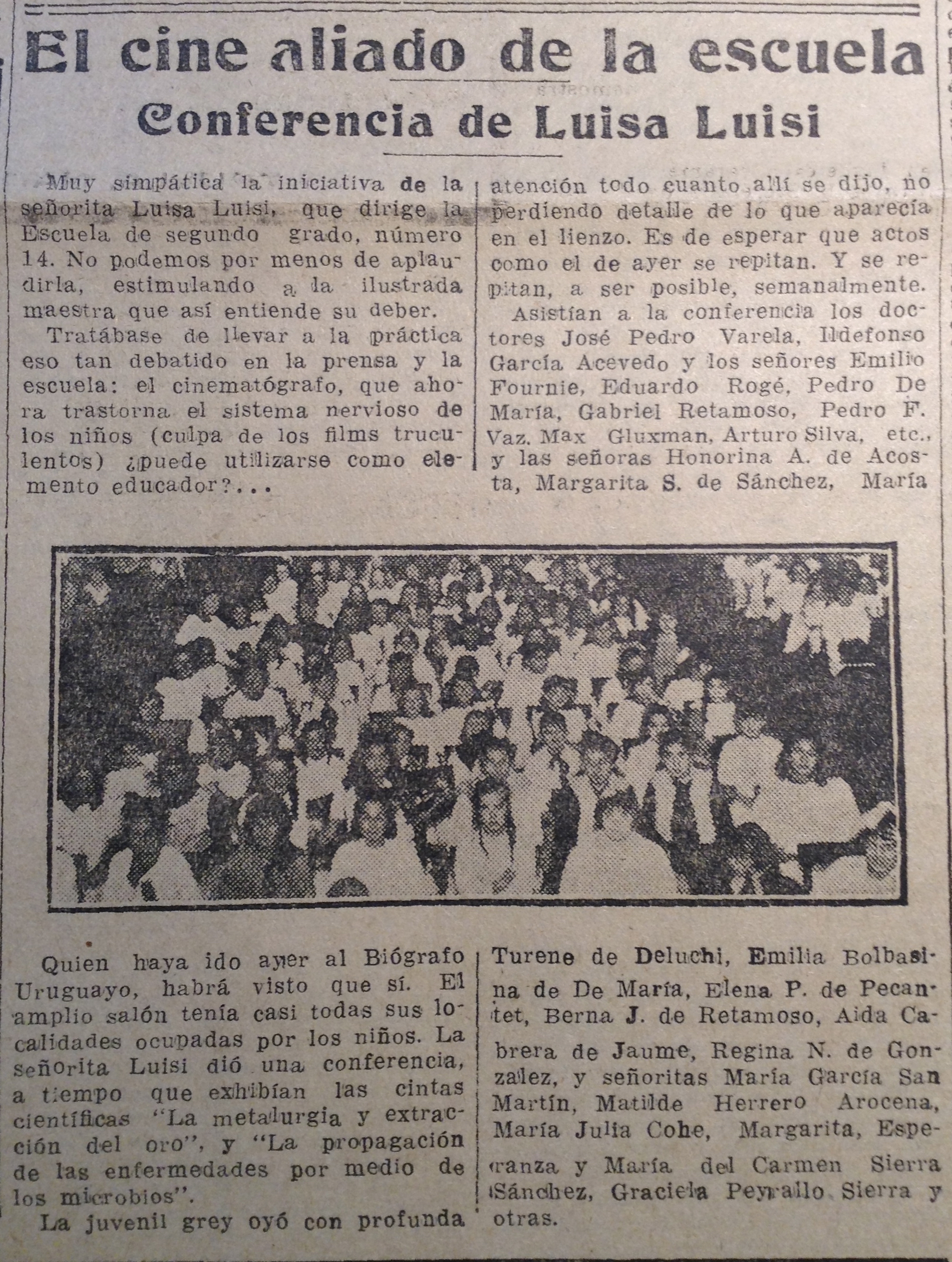
The children at Luisa Luisi’s conference screening. “El cine aliado de la escuela.” La Razón (22 May 1917).
Both Ibarbourou and Parodi Uriarte would appear a few years later, along with ten other female intellectuals and university graduates, to support a project for the monopolization of cinema by the State, as developed in the publication El biógrafo (1926) by Enrique Barlocco.49The complete list of signatories contains Professor of Micrography and assistant of the Pathological Anatomy Laboratory of the Faculty of Medicine (but also poet) Nylia Molinari Calleros; the poets Juana de Ibarbourou and Esther Parodi Uriarte; the pedagogue and publicist Enriqueta Compte y Riqué; the poet, writer and educationist Luisa Luisi; Ema Elsa Tiribocchi, the head of the Obstetric Clinic in Maternity; Elisa Barros Daguerre, the head of the Clinic of the Faculty of Medicine and Head of the Group at the University for Women; the legal consultants Rosa Mautone Falco, Sofía Álvarez Vignoli de Demicheli, and Noel Demateis; the educationist Aurora Velazco de Brunetto; and Dr. Ángela Scalone. Apart from the cinematographic project, this small book contains another project, devoted to the promotion of a national construction of machinery, Academy of Inventions. In it, Barlocco looks for support from eleven personalities of Uruguayan culture, in this case, all men. The gesture is significant as it allocates specific fields to specific genders: if inventions and machines are masculine matters, cinema is female, something that accounts for the strong association between the cinema and women in the country. Enrique Barlocco, El biógrafo. Academia de los inventos (Montevideo: Imp. La Uruguaya, 1926). In the booklet, these twelve public figures were asked to write brief statements endorsing the ambitious project to reduce the hegemony of foreign cinema. This is the only known example of Uruguayan women openly advocating for a national cinema.
Among these twelve women, we also find one of the most prominent voices in the field of education, that of the feminist writer, intellectual, and educator Luisa Luisi, a member of a middle-class Italian immigrant family whose sisters were the first female university students in Uruguay. Her link to cinema was well known by then and mirrored the pedagogical impulses within the charity sphere mentioned earlier in this essay. Almost a decade earlier, in 1917, Luisi organized the conference “Cinema, a School Ally,” held in the Biógrafo Uruguayo, which was conceived to be laboratory for testing the potentialities of films projections in pedagogical contexts.50“El cine aliado de la escuela. Conferencia de Luisa Luisi.” La Razón (22 May 1917): 5. On the pioneering figure of Luisa Luisi, see Lourdes Peruchena, “Las desobedientes. Luisa Luisi, entre Concepción Arenal y Virginia Woolf, un pionero pensamiento feminista desde el sur.” Contemporánea. Historia y problemas del siglo XX 11, no. 13 (August-December 2020): 65-74. According to one newspaper chronicler, Luisi achieved this successfully by combining her speech with the screening of scientific and industrial films in front of an audience comprised of mesmerized children and prestigious intellectuals of the time. Remarkably, one article also offers photographic “proof” of the children’s interest.51“El cine aliado de la escuela.” Two years later, in her booklet Educación Artística, (1919), Luisi would mention the cinema as “an irreplaceable factor in school: not only as a teaching instrument but also as an educational, moral and artistic medium.” Luisa Luisi, Educación Artística. Trabajo presentado al Congreso Americano del Niño (18-25 Mayo 1919) (Montevideo: Renacimiento, 1919): 74.
To return to the notion of “diverse figures,” it is possible to map out a variety of ways that women outside of the upper class engaged with cinema during the silent era. These scattered but very specific examples of intellectual and literary engagement with cinema by female writers, poets, and thinkers show how women, in fact, not only participated in film screenings and events to promote and fund their charitable work. They also reflected upon the possibilities of the national cinematic production (opening debates their male counterparts chose not to participate in), elegantly included the new medium in their literary creations or used it to further their artistic practices, and actively participated in the discussions around the importance of cinema in Uruguay.
Intellectuals, poets, writers, and doctors (signatories in El biógrafo): Teresa Santos de Bosch, Elena Crosa de Roxlo, María Laura Viana Giuria, Juana de Ibarbourou, Esther Parodi Uriarte, Nylia Molinari Calleros, Enriqueta Compte y Riqué, Luisa Luisi, Ema Elsa Tiribocchi, Elisa Barros Daguerre, Rosa Mautone Falco, Sofía Álvarez Vignoli de Demicheli, Noel Demateis, Aurora Velazco de Brunetto, Ángela Scalone, Edgarda Cadenazzi.
Charity and the Uruguayan Flapper: Del pingo al volante (1929)
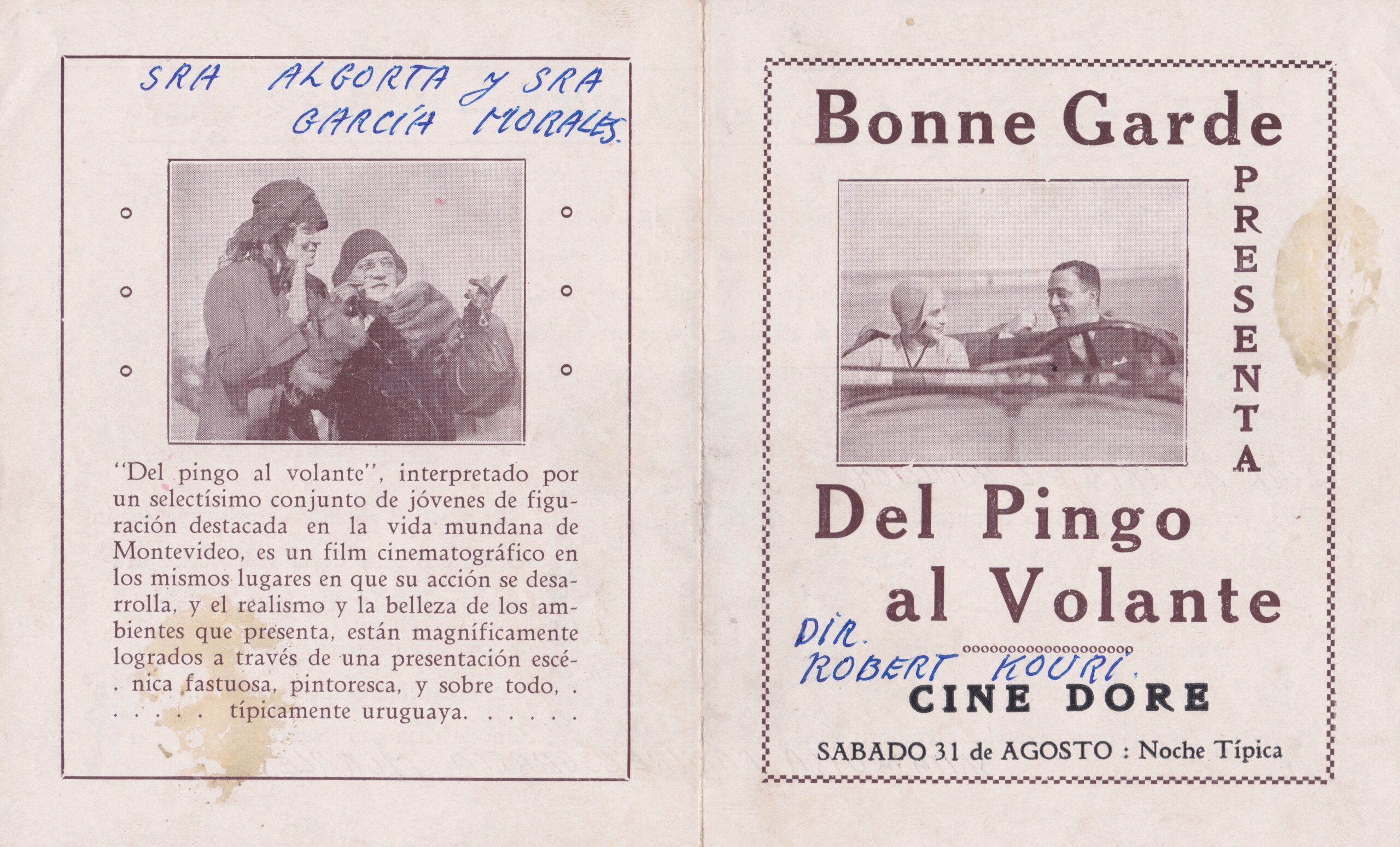
Film program, Del pingo al volante (1929). Private Collection.
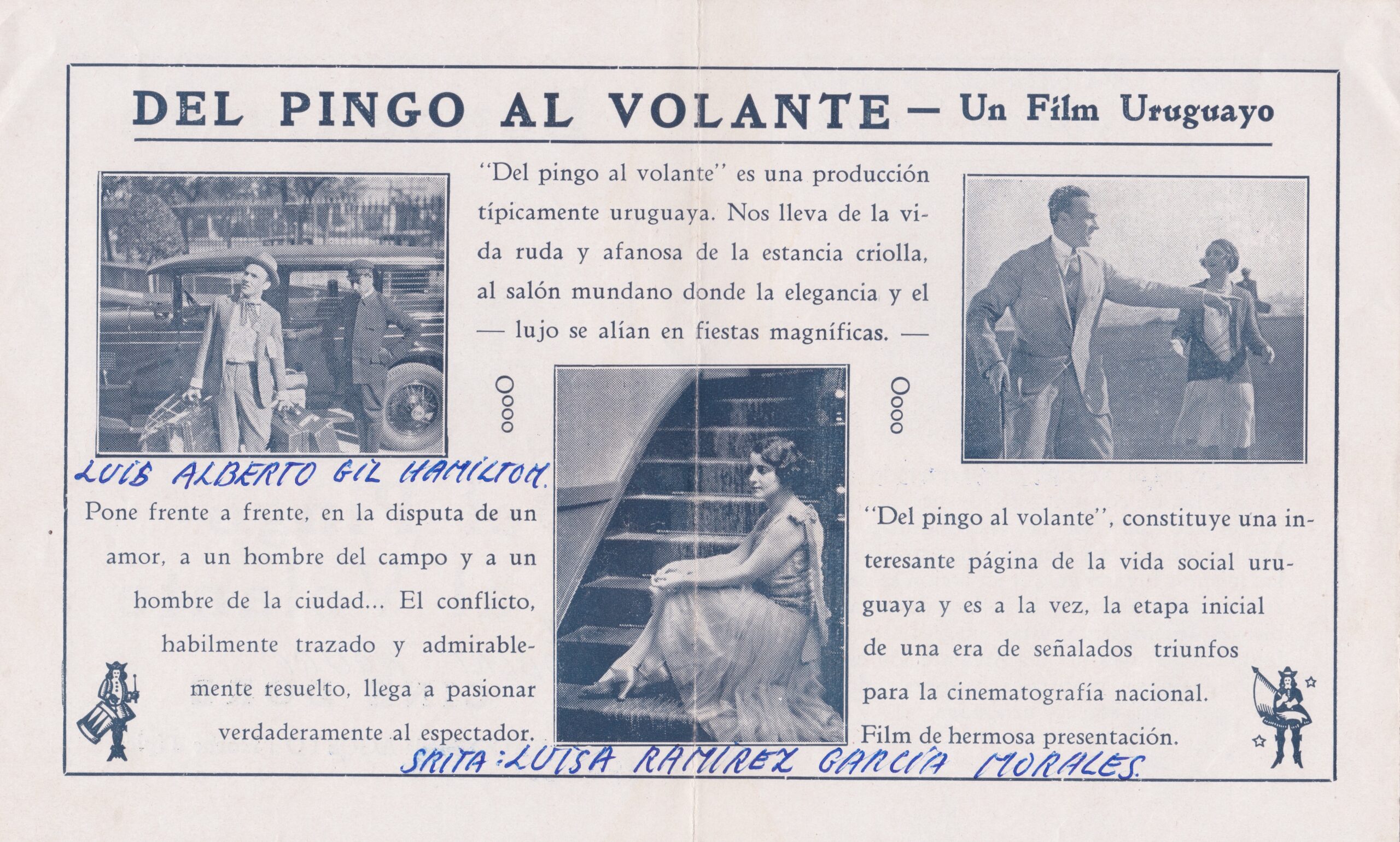
Film program, Del pingo al volante (1929). Private Collection.
Del pingo al volante/From the Racehorse to the Steering Wheel premiered in 1929. It was produced by Bonne Garde, an association that helped single mothers with their newborns by giving them instruction and housing, under the guidance of Ana Chain de Piñeyro. It starred Luisa Ramírez García Morales—in the role of Susana Aguiar—a member of the elite, as was the rest of the cast.52“El film pro-Bonne Garde. Del pingo al volante.” La Mañana (10 August 1929): 3. The rest of the female cast included Mrs. de García Morales, Cotina Jiménez de Aréchaga, María Elena Algorta Guerra, Marta Preve Thevenet, María Adelaida Ramírez García Morales, Renée Pietracaprina Méndez, Emilia Varzi Castell, and Sarita Etchegaray Vidal. Fortunately, the film is still extant and is held at the Cinemateca Uruguaya.53The film was digitized in 2018 by the Laboratorio de Preservación Audiovisual (UdelaR) and is available online as of this writing: https://youtu.be/OsCxamBqvq0. For more information, see: https://archivosdocumentales.udelar.edu.uy/index.php/del-pingo-al-volante This digitization integrated some parts of the film previously unavailable. My analysis of the film is based on this new version.
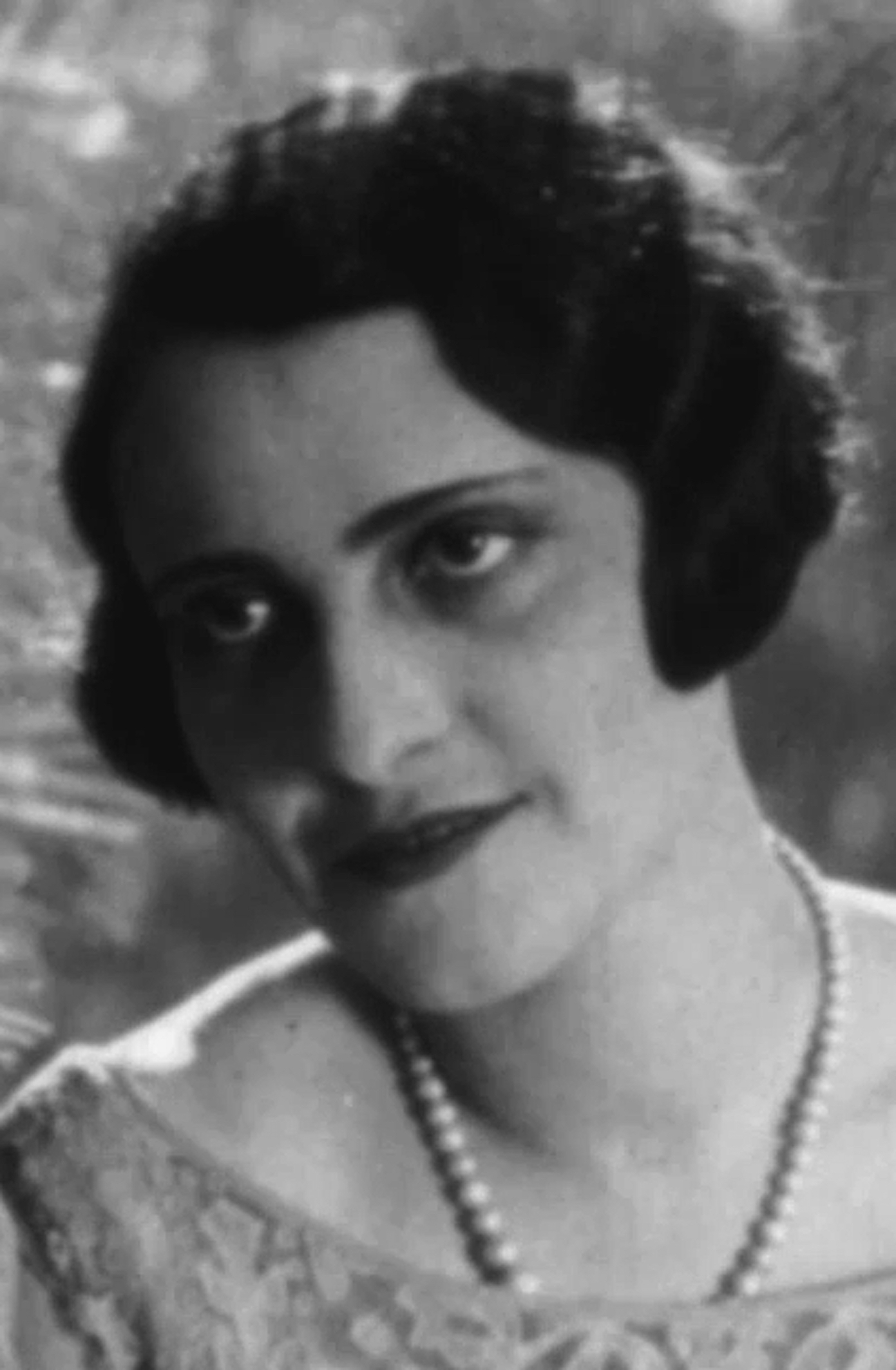
Luisita Ramírez García Morales, frame enlargement, Del pingo al volante (1929). Courtesy of LAPA (AGU- UDELAR) and the Cinemateca Uruguaya.
Directed by Robert Kouri, the film reflected, as Pervanche did, the anxieties of the upper class, staging a family in decline whose only economic salvation was the marriage of Susana to a rancher cousin who was obviously rich. Susana does not suspect that a plot for the two to meet is planned by her mother and the family’s notary. To complete the (necessary) love triangle, and ignite the action, the film includes an indolent and equally rich man from Montevideo. Christine Ehrick has argued that Del pingo al volante “is most obviously a film about modernity and masculinity, but it is also a film about breeding and the reproduction of elites.”54Ehrick, “Beneficent Cinema,” 216. She also rightly refers to Susana’s mother’s power within the plot. Building on that, it is essential to emphasize that Del pingo al volante also represents Susana as part of a new generation of women, one that adopts flapper haircuts and fashionable dresses, and hints at the girl’s possible rebellious attitude. Not only is the young protagonist rather independent, speeding around town in her own car, but early in the film, in response to the wedding solution offered by the notary, her mother replies: “A marriage? For God’s sake, doctor! Susana is a very difficult girl…” Yet as the film progresses, the audience understands—and is therefore reassured—that her “difficulty” is only a mild one and that it will eventually be overcome by love. Thus, while this new generation of women was represented in the film as fashionable and modern, they were not politicized like the more feminist figure of the New Woman. And while the film seems to allow Susana a final say—she ends up choosing the “right” mate, her cousin, without discovering her mother’s plot—she ultimately helps to maintain her family’s economic position. Thus, Del pingo al volante portrayed a national version of the moderate (upper-class) flapper.55Although the film was reviewed in the press, nothing was said about its depiction of this modern woman. It is thus not possible to know how the press or the female audience members understood the protagonists.
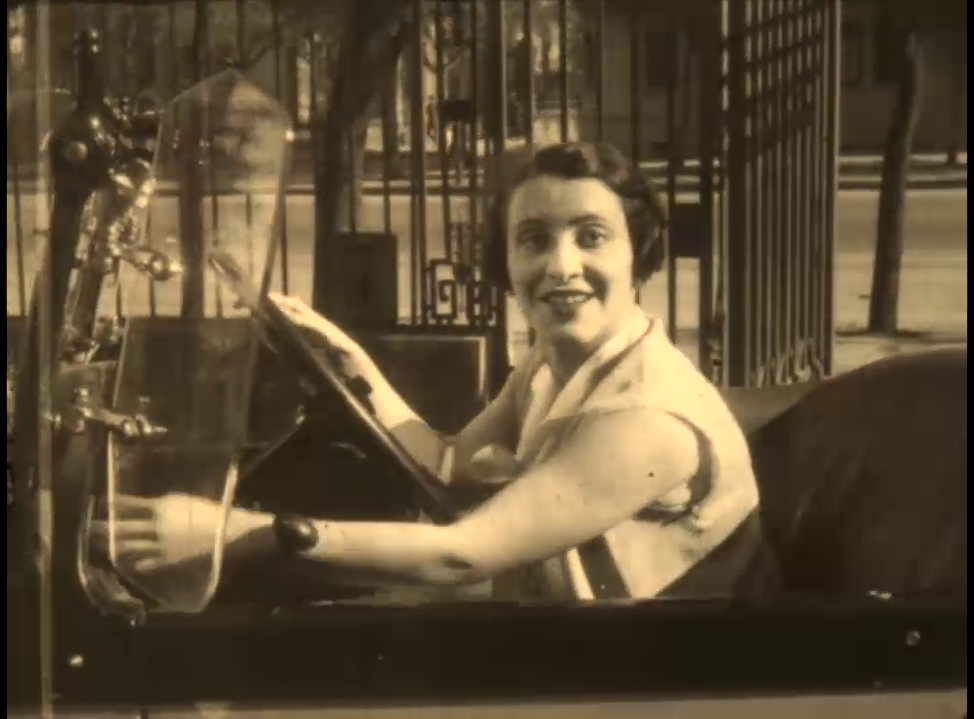
Frame enlargement, Del pingo al volante (1929). Courtesy of LAPA (AGU-UDELAR) and the Cinemateca Uruguaya.
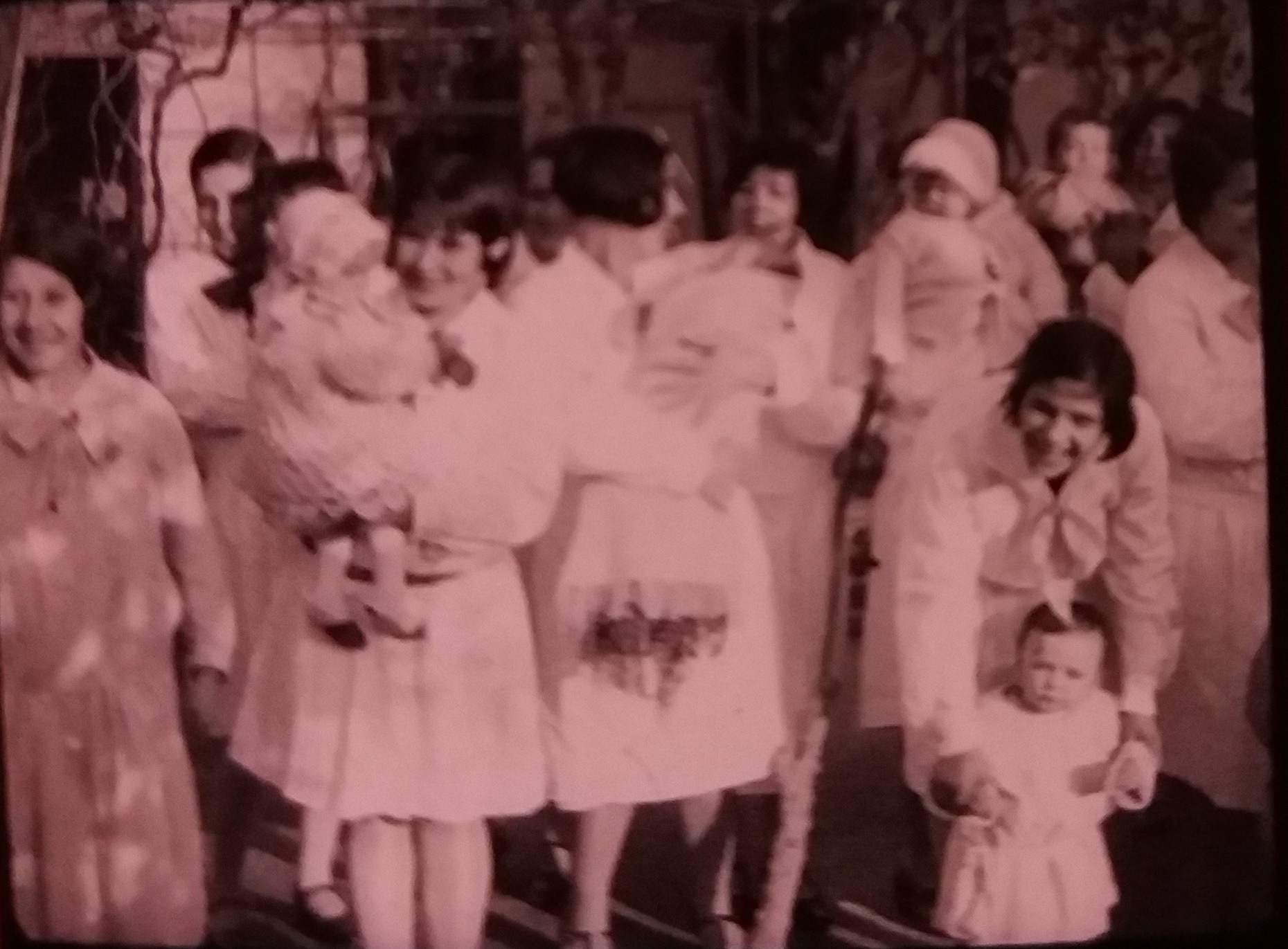
Frame enlargement, La Bonne Garde (1929). Courtesy of LAPA (AGU- UDELAR) and the Cinemateca Uruguaya.
Del pingo al volante is a story about the upper class and, through it, Bonne Garde presented images of a world familiar to its members. Likely that same year, the charitable association also produced a short documentary film, titled La Bonne Garde, about the institution’s house for single mothers.56 For further information, see Ehrick, “Beneficent Cinema,” 211-213; Torello, La conquista, 164-166. The film, which is also still extant and held at the Cinemateca Uruguaya, shows the practical side of the association’s work: groups of young mothers with their “saved” children in a safe environment. In short, it complements Del pingo al volante and serves as an equally effective platform for advertising Bonne Garde’s mission. In other words, it is rather fruitful to think about these two productions together as it shows more clearly Bonne Garde’s aims. (Even if no information was found about the production, or even the premiere, of La Bonne Garde, it is likely that these two films were produced simultaneously.)57Both the documentary and Del pingo al volante have similar intertitles (fonts and frames). This would corroborate 1929 as the year of production, the date proposed by the Cinemateca Uruguaya. With one film, the organization portrayed the lively and entertaining (imaginary but credible) activities of the elite families, while, with the other, it presented the hard reality of young, single, and poor mothers, whose only hope came from the help provided by young women like the heroine of Del pingo al volante. In this sense, the elite’s version of the modern woman was one who could alternate between her luxurious, active, and fashionable world and the world of women in need.
Del pingo al volante producers and actresses: Ana Chain de Piñeyro, Luisa Ramírez García Morales, Mrs. de García Morales, Cotina Jiménez de Aréchaga, María Elena Algorta Guerra, Marta Preve Thevenet, María Adelaida Ramírez García Morales, Renée Pietracaprina Méndez, Emilia Varzi Castell, Sarita Etchegaray Vidal.
Movie Theaters and Musicians
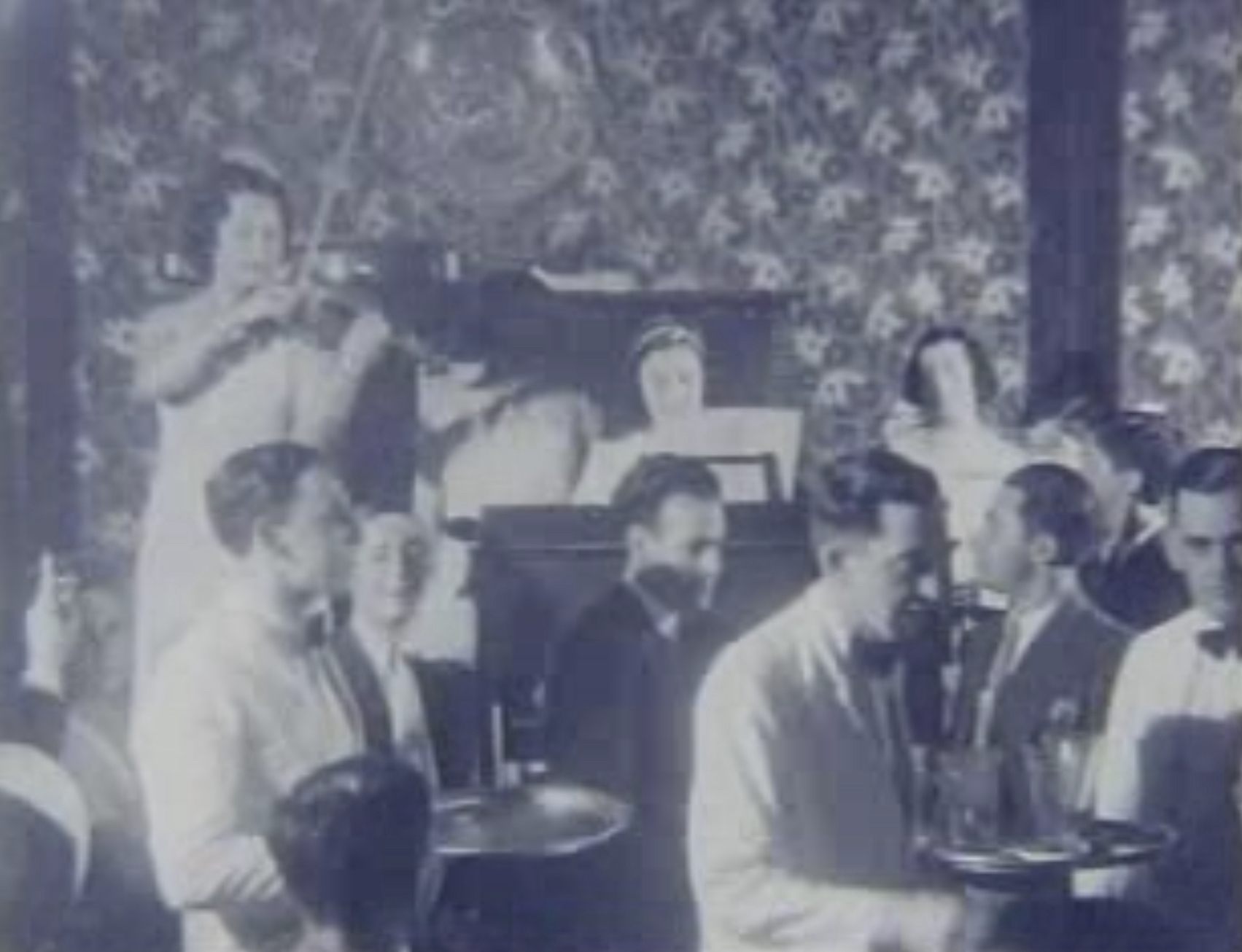
Frame enlargement, a ladies orchestra, unknown film, c. 1920. Courtesy of SODRE.
Female musicians in cinema theaters were less frequently employed than men but not unusual. In actuality, from the 1920s onward, musical performances by women took place, both in the capital and inland. While there are no specific studies on the subject, it is possible to relate this appearance in movie houses and, therefore, in the professional sphere, with the education Uruguayan girls received between the end of the nineteenth century and the beginning of the twentieth. Indeed, in the private realm, music was a key part of the female elite and middle-class upbringings and, as researcher Marita Fornaro has pointed out, the “nineteenth-century piano is the adornment of marriageable young women, who after their marriage can play it during family reunions.”58Marita Fornaro Bordolli, “María Eugenia Vaz Ferreira y la música: las invisibilidades múltiples.” In María Eugenia Vaz Ferreira. “Me muestro siempre en mi oscuridad, ” eds. Hugo Achugar and Marita Fornaro (Montevideo: MEC, 2013), 35. Likewise, as the century progressed, girls began to study in conservatories located in different parts of the country, graduating as piano, music theory, and violin teachers. Following the steps of Jacinta Furriol, Carmen Luna, Orfilia Pozzolo, and Dolorcita Renteia, all composers from the nineteenth century—as Roberto Lagarmilla pointed out in his chapter about “Woman in Uruguayan Music”—some of these educated women composed, published, and premiered their opuses, as was the case with María Galli, María Eugenia Vaz Ferreira, Carmen Barradas, Aurora Calo Berro, Socorrito Morales de Villegas, and María Esther Roosen de Regalía.59For information about these composers, see Roberto Lagarmilla, Músicos uruguayos (Montevideo: Editorial Medina, 1970); Mirta Amarilla Capi, La música en el Uruguay. Los compositores de música culta (Montevideo: Ediciones del eclipse, 2000).
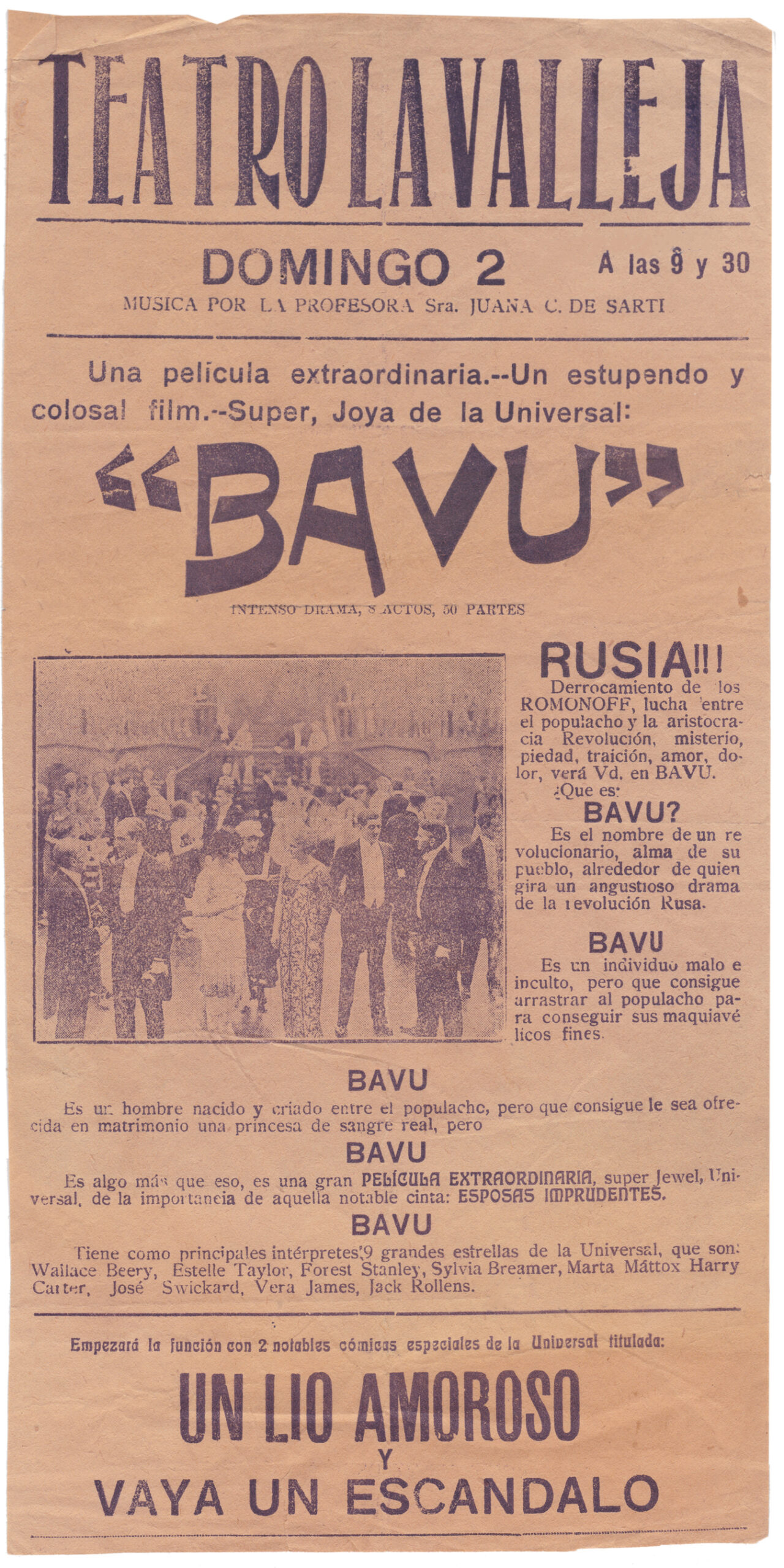
Music by Professor Juana C. de Sarti. Film program from Teatro Lavalleja, c. 1924. Private Collection.
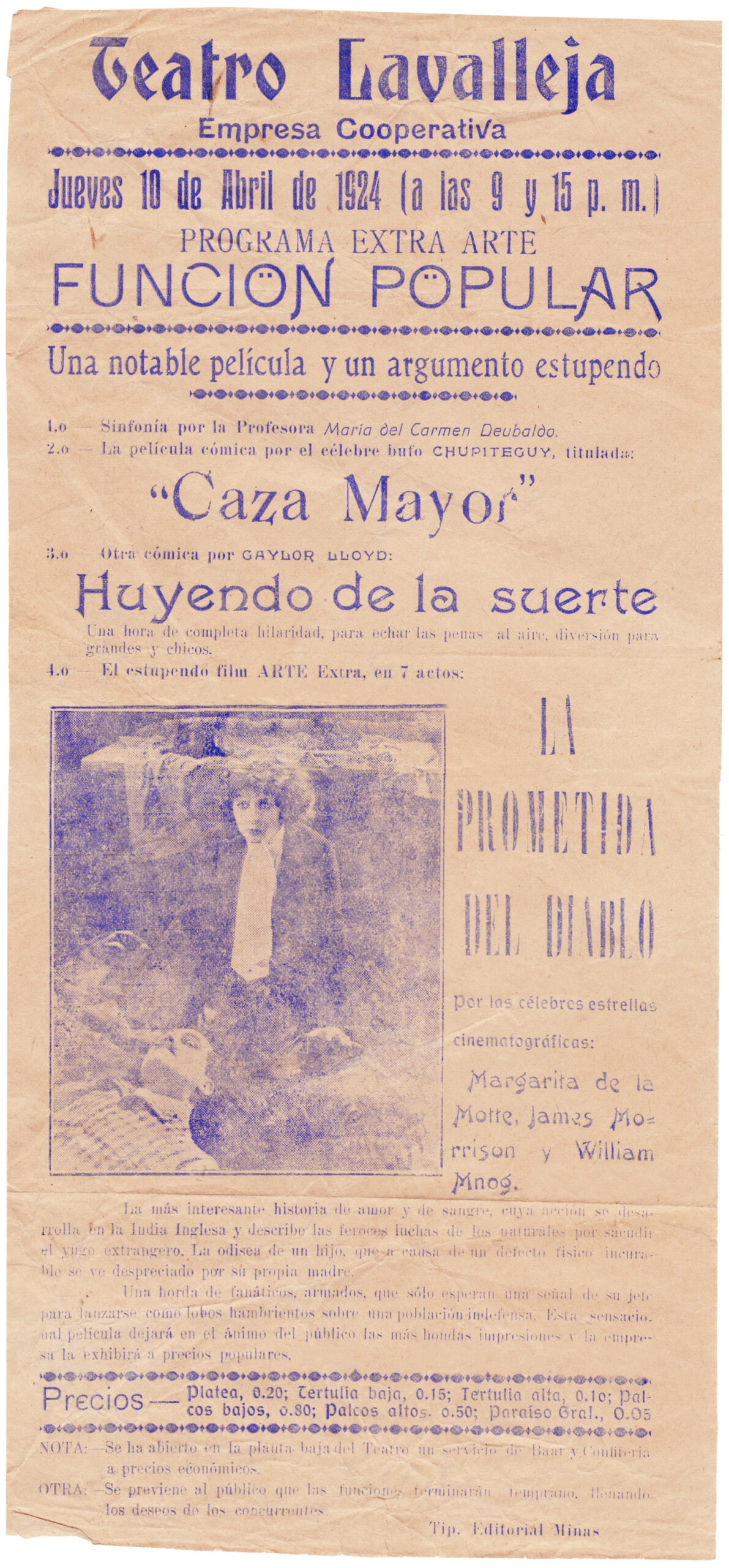
Symphony by Professor María del Carmen Deubaldo. Film program from Teatro Lavalleja, 1924. Private Collection.
Our movie theater musicians thus had, undeniably, multiple female role models. From 1900 up to the 1920s, female orchestras and soloists, some of them mentioned above, used to appear in the press. But unlike these musicians, performing often at charitable events, middle-class female musicians in movie theaters (like their masculine counterparts) did not seem to reach the press. Some information about them, however, can be found directly in film programs. The ephemeral nature of this material, and the lack of significant collections in Uruguayan archives, makes any kind of survey extremely difficult and somewhat random. An important private collection of film programs from the inland city of Minas (Department of Lavalleja), somehow scattered among collectors, shows that women’s participation in cinema theaters as musicians spanned the 1920s. Between 1920 and 1925, professors Juana C. de Sarti, María del Carmen Deubaldo, and Adelina Salazar were often in charge of the musical performances at the Teatro Lavalleja. By 1927, Sisa Bonino, Ignacia Poroli, and violin teacher Miss M. Demicheli, also a member of the Orquesta Cañela, played at the Teatro Escudero. Lastly, in 1929 a Professor Minita Ricetto de Acciari was performing a symphony at the Teatro Florida, in the inland city of Florida.
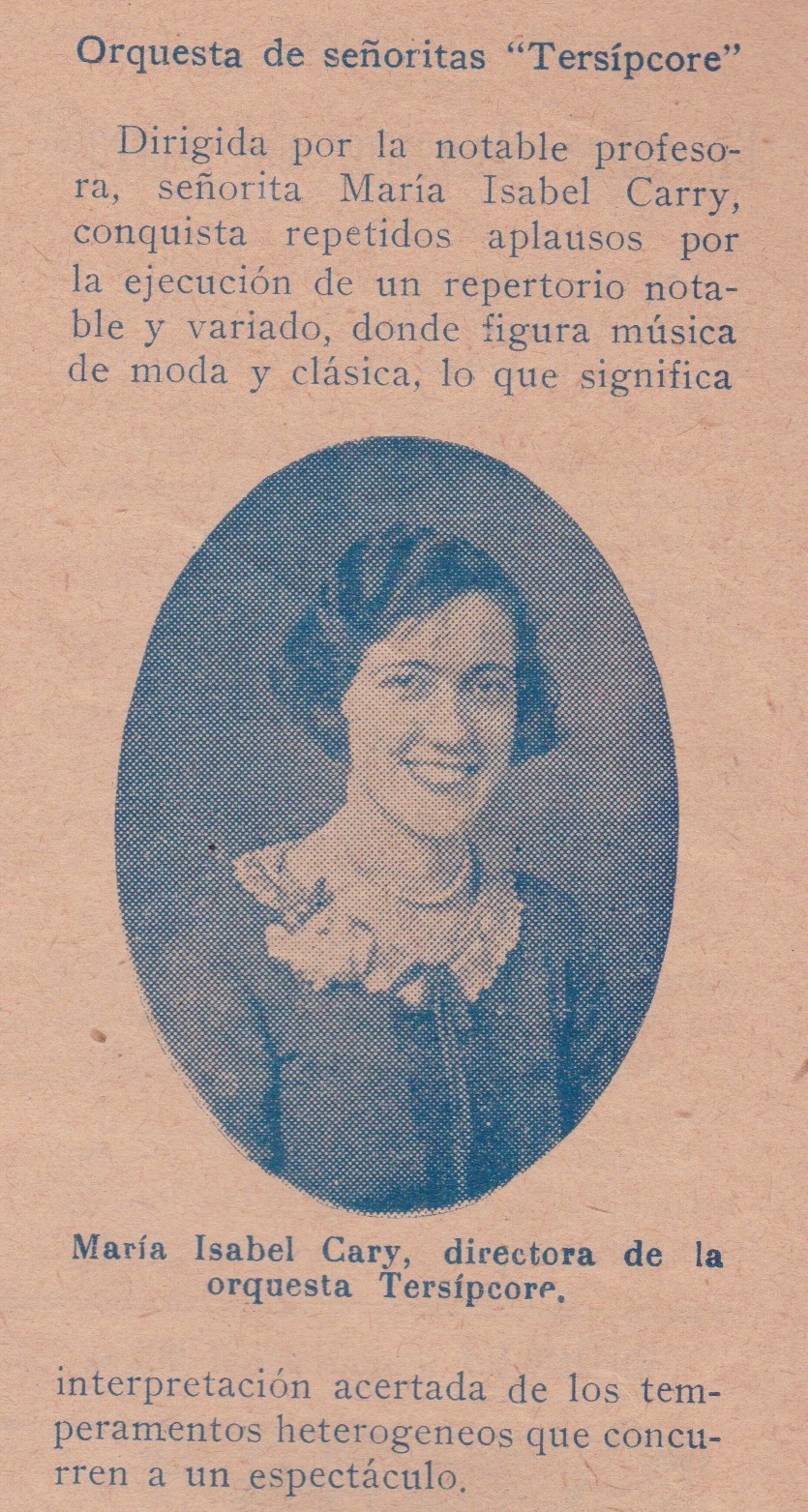
María Isabel Cary, director of Tersípcore Ladies Orchestra “El cine Plus Ultra,” in Uruguay Cinema 1, no. 5 (5 November 1927).
For Montevideo, even less information can be gathered. I found only one, but rather significant, mention of a woman playing in cinemas in the magazine Uruguay Cinema. In 1927, María Isabel Carry—or Cary, the spelling changes in the same article—was the conductor of the Tersípcore Ladies Orchestra that usually performed at the Cine Teatro Plus Ultra. As the article stated, “she garners extended applause for the performance of an outstanding and varied repertoire, featuring fashionable and classical music that properly interprets the heterogeneous temperaments enjoying the show.”60“El cine Plus Ultra.” Uruguay Cinema 1, no. 5 (5 November 1927): 13. Although not much data is given, the way the article presents Tersípcore—that is, as nothing out of the ordinary, just a modern orchestra—allows us to conjecture that a certain number of female orchestras regularly performed during the period, maybe even in movie theaters, but were simply forgotten. Finally, The Golden Book of Cinema in Uruguay, written in the 1950s, devoted a chapter to musicians of the silent era. It included a long list of orchestras and male performers, but only cited two women: Libertad Balsán at the Cine Porteño and the unnamed “daughter of Don Angelo, the businessman from Cine Olivos.”61Luciano Mosteiro, ed., El libro de oro del cine en el Uruguay. Special Dossier for the magazine Cine Radio Actualidad XX, no. 1000 (September 1955): 22. See also, Osvaldo Saratsola, Función completa, por favor. Un siglo de cine en Montevideo (Montevideo: Ediciones Trilce, 2005). Mosteiro does not give dates. However, if one looks at information about cinema theaters’ activities contained in Saratsola, Libertad Balsán could have played between 1923 and 1926, and the unnamed daughter of Don Angelo, between 1910 and 1923 (271-2).
The names of these middle and potentially working-class women revealed here allow us to think of female performances in movie theaters in the first decades of the century as important professional (cinematic) work. Not only are they instances of female engagement with cinema outside of the elite (charity) sphere, but they also go beyond the domestic musical activities of “marriageable” girls or the conservatory environment. Their names also return to us a space in the new modern social order in which these women took part and, in which, following the fast and multiple images on the screen, they could improvise and create music with their pianos, violins, and orchestras as part of their jobs.
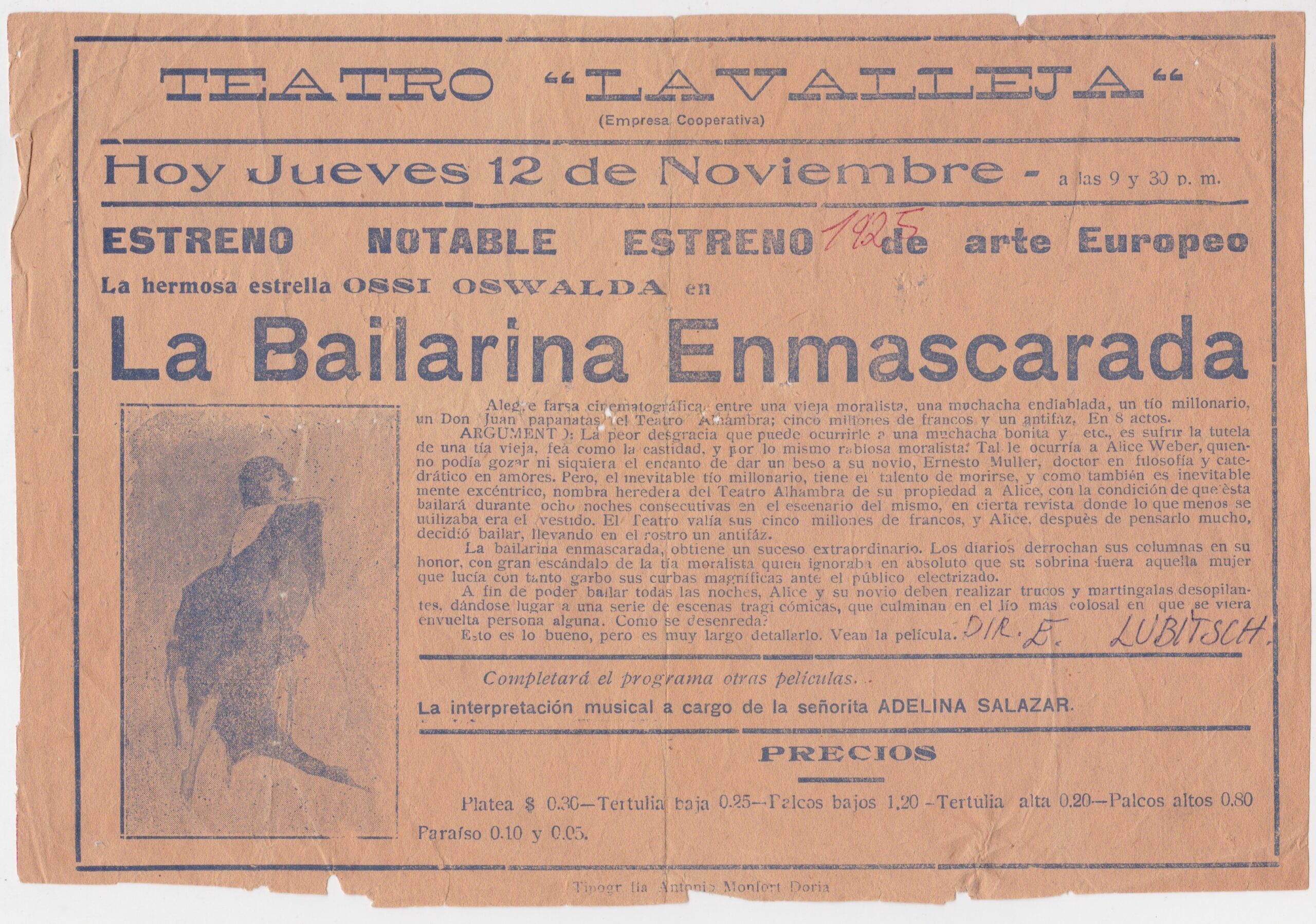
Music by Adelina Salazar. Film program from Teatro Lavalleja, 1925. Private Collection.
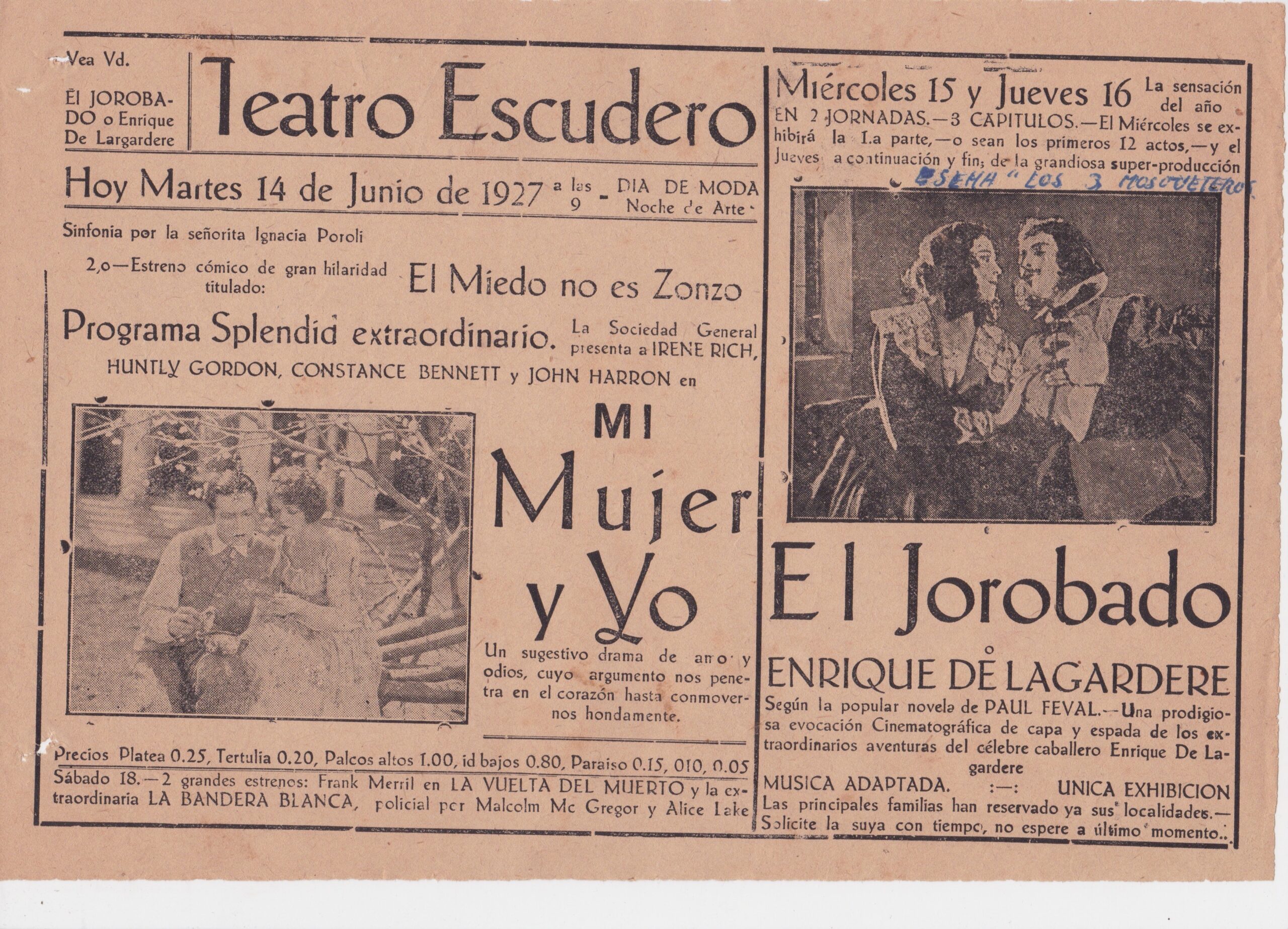
Symphony by Ignacia Poroli. Film program Teatro Escudero, 1927. Private Collection.
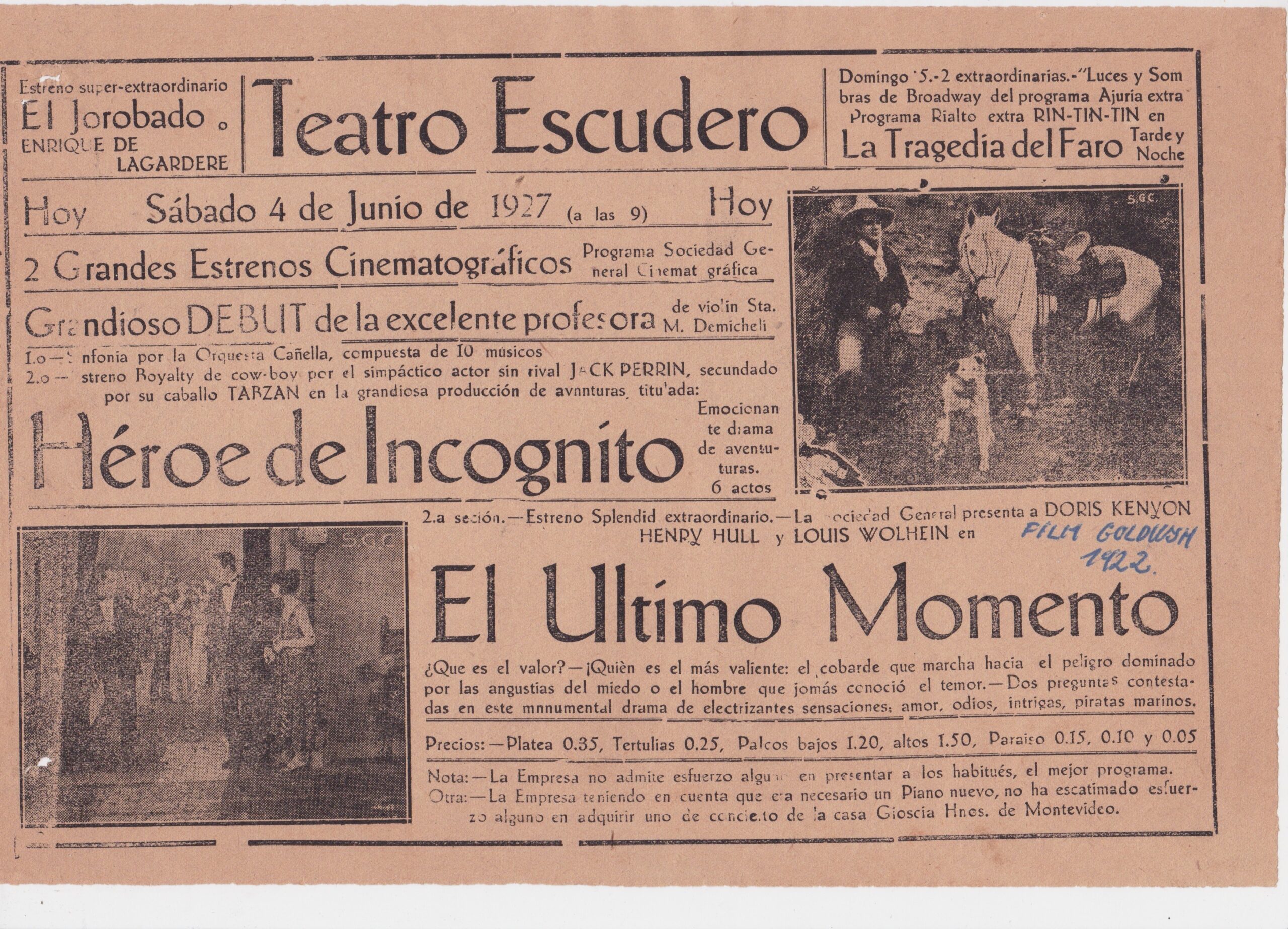
Grandiose debut by violin professor M. Demicheli. Film program from Teatro Escudero, 1927. Private Collection.
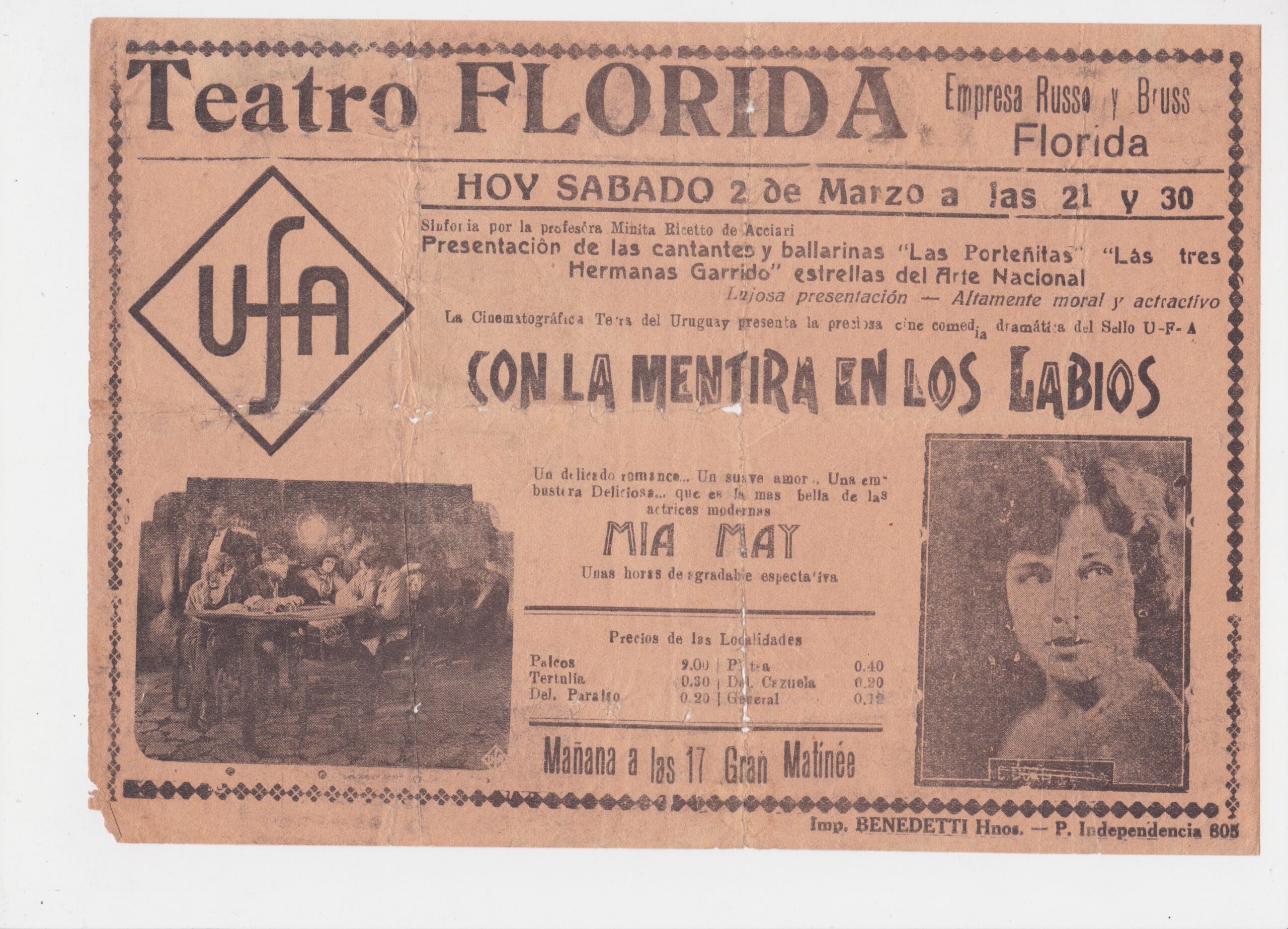
Symphony by Professor Minita Ricetto de Acciari. Film program from Teatro Florida, 1929. Private Collection.
Musicians in movie theaters: Sisa Bonino Juana C. de Sarti, María del Carmen Deubaldo, Adelina Salazar, Ignacia Poroli, Miss M. Demicheli, Minita Ricetto de Acciari, María Isabel Carry (Cary), Libertad Balsán, the “daughter of Don Angelo.”
Closing and Opening
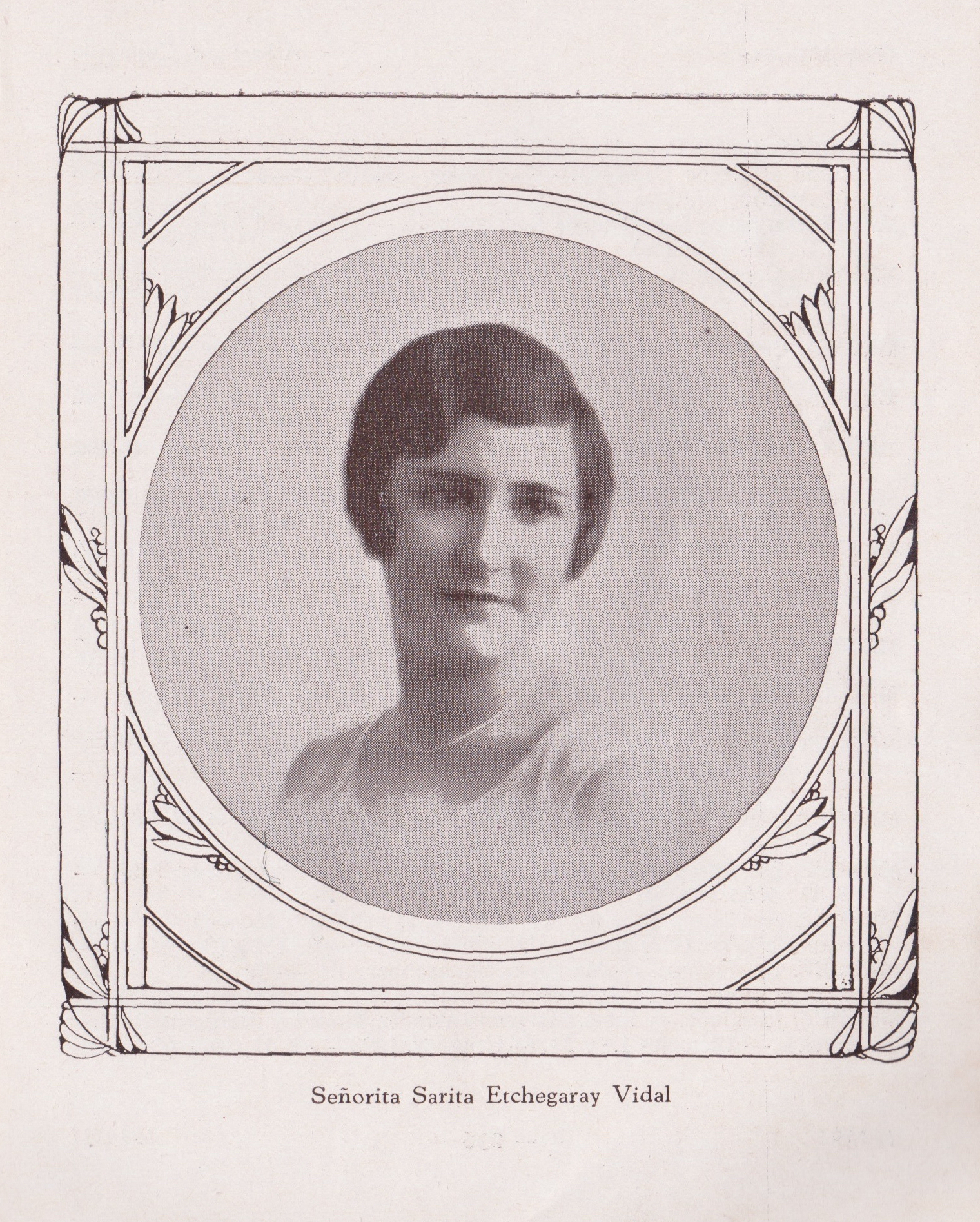
Sarita Etchegaray Vidal, who appeared in Del pingo al volante, in Guía mundana del Uruguay VI, 1930-1931.
Through extensive research in the press and archives, this overview essay explored the wide-ranging participation of women in the precarious Uruguayan cinematographic field of the early twentieth century. It constituted a first mapping of the areas in which mostly upper to middle class women contributed to the construction of the cinematographic field of the period. Doing so, they significantly set a model for how to understand cinema for other women: those reading the newspapers and learning about the cinematic events organized by the charitable associations; those watching a charitable film; those reading their critical writing about cinema; or those listening to the music played by one of the artists mentioned above. While not the focus of this essay, the female audience—an entity that has gained much academic attention in the last decades—was the ideal public for all these women’s work. This unknown group of women from all strata of society is, in a way, also present here.
My use of “name dropping,” perhaps at times exasperating, was intended to make specific women’s contributions to the field visible. Not only as part of categories (actresses, intellectuals, musicians, etc.) or groups (charities), but as concrete people, with names, surnames, and bodies, who progressively engaged with the cinematographical field. To show these different, and often overlapping, modalities, I chose to present my research chronologically instead of grouping all the charity-related work together, for example. The kind of name-rescue that I do here is only possible due to surviving, and fragile, pieces of evidence, such as photos, programs, invitations, films, articles in newspapers, and novels. These artifacts functioned here in two ways: as a concrete and verifiable foundation for my research, and as substitutes for a presence that, until now, seemed non-existent. As secular contact relics, in other words, every piece of information kept us “close” to the protagonists. In its incompleteness, this essay also seeks to lay the foundation for future studies. Now that we do have some names, much more remains submerged, anxiously awaiting to be discovered and analyzed.
See also: “Writing the History of Latin American Working in the Silent Film Industry”

